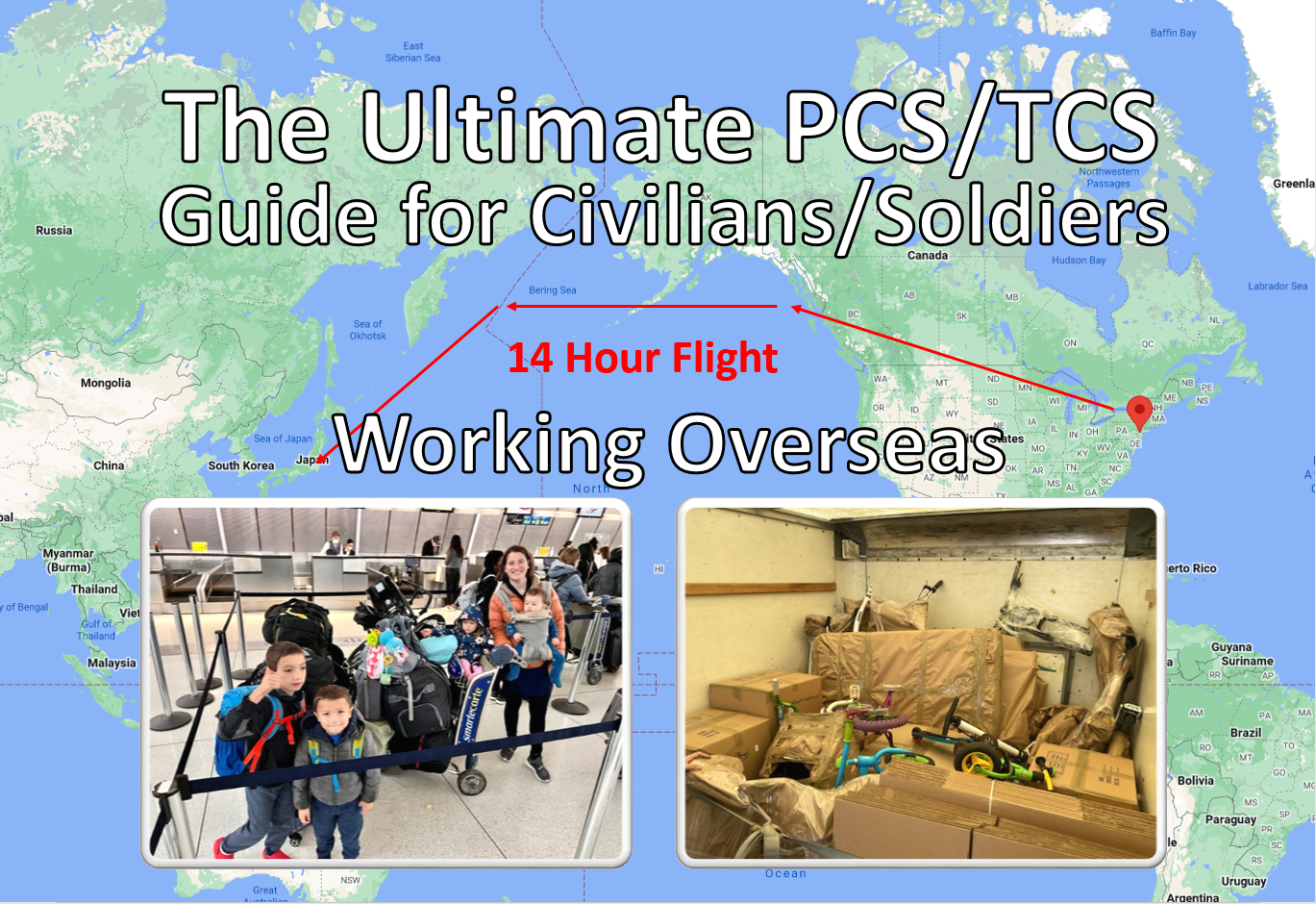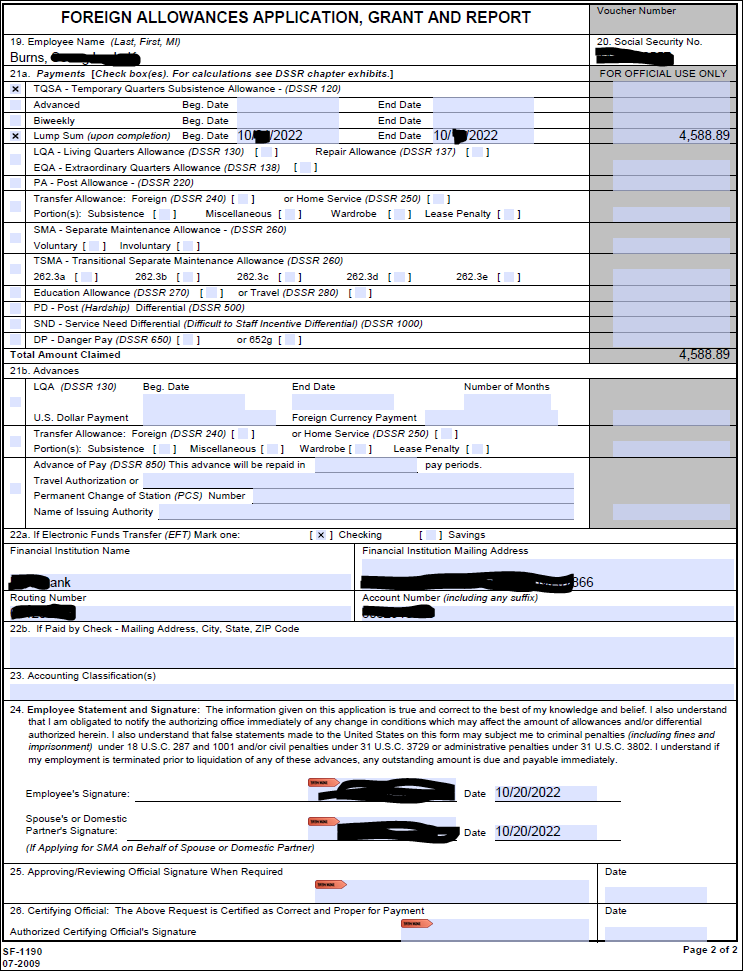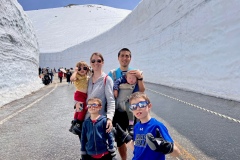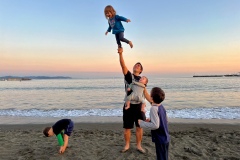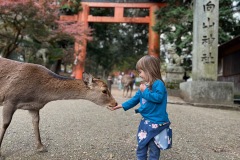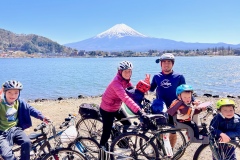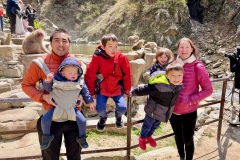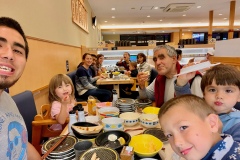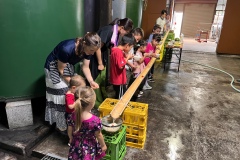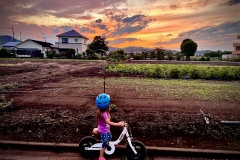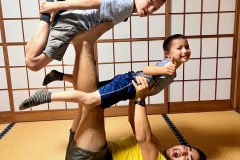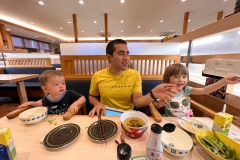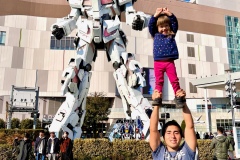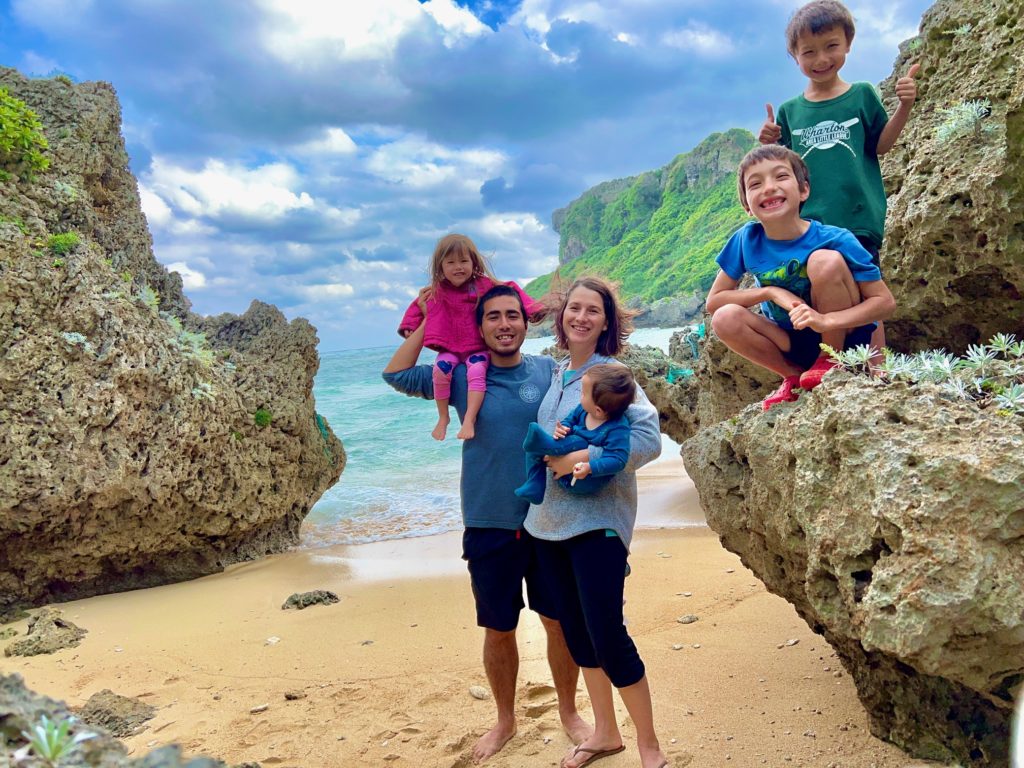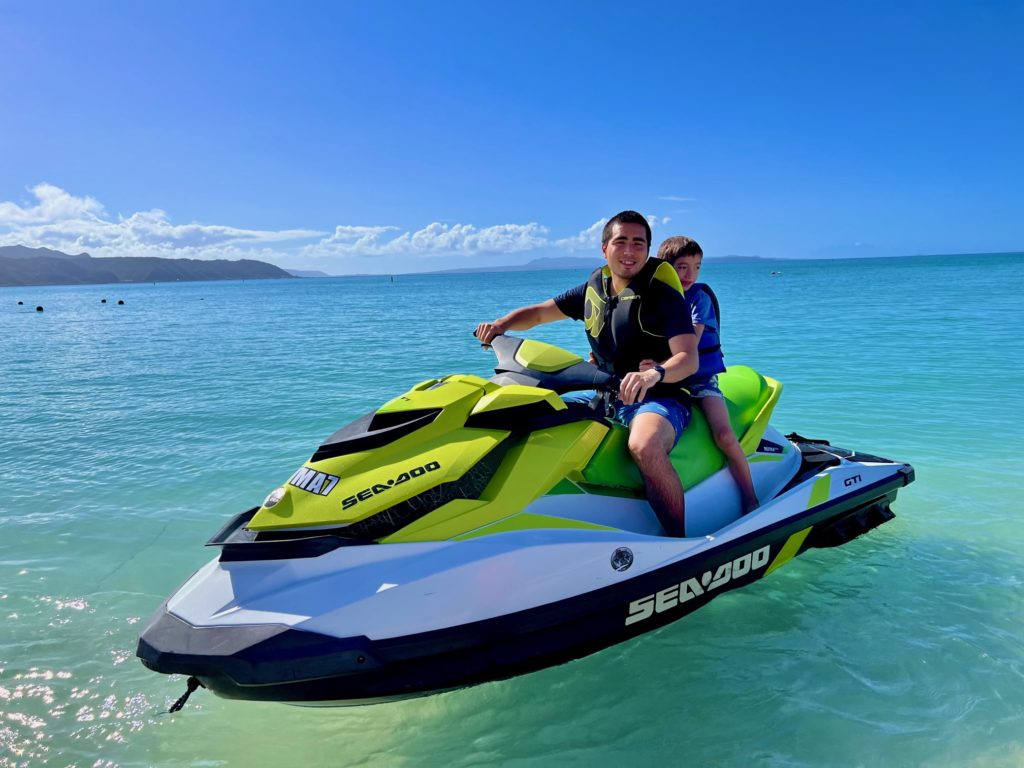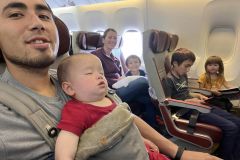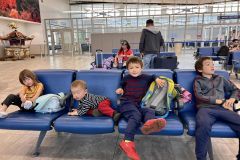This guide is mostly for Federal Civilians (Can Apply to Active-Duty Soldiers too) who have orders to work overseas temporarily (can apply to Permanent too). If you are looking to join the US Government or just want to look for International USG positions (Make sure the position comes with Relocation Entitlements) check out www.USAJOBS.gov
In 2022, I was accepted into the Engineering & Scientist Exchange Program (ESEP) and started working as a research engineer for the Japanese Ministry of Defense for an entire year (OCT 2022 – SEP 2023).
Under Temporary Change of Station (TCS) Orders, I took my Family of 6 from our home in New Jersey to live in Japan for the year, and the USG paid for all of our plane tickets, shipment of household goods, first few weeks of Hotels and Meals (Up to $600/day), Rent Payments (Up to $3400/month) and Miscellaneous Expense Allowance ($1300).

There is a lot of steps needed to get ready to TCS/PCS (Permanent Change of Station) and while there are many guides out there about preparing the HHG, I feel there was no detailed guide on all the intricate details of all that is required to move abroad for a year, so that is what I want to document here to provide an ultimate guide for others to follow.
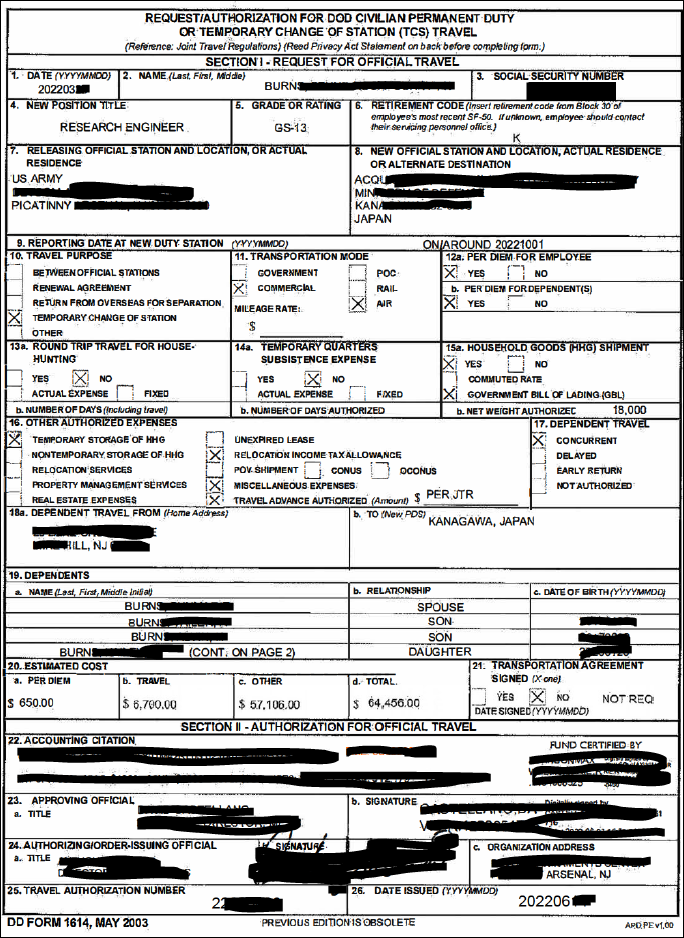
Official Passports
In order to fly with official orders (TCS/PCS) you need an Official USG passport for yourself and any dependents that are on your orders. The closest location for us to get the passports was an hour away in West Point NY. There was no cost to us, but we had to make a separate application for all 6 of us and it took 4-weeks from application to getting them. West Point would have taken the passport photos for us, but we ended up taking them at my workplace in Picatinny Arsenal, NJ.
Some countries require VISAs, but in the case of Japan, when we arrived in Country they Stamped our passports with a Status of Forces Agreement (SOFA) stamp and that worked in Japan in lieu of a visa. At the time of our arrival in October 2022, we also needed to all (3 and up) be COVID tested within 72-hours of flight departure.
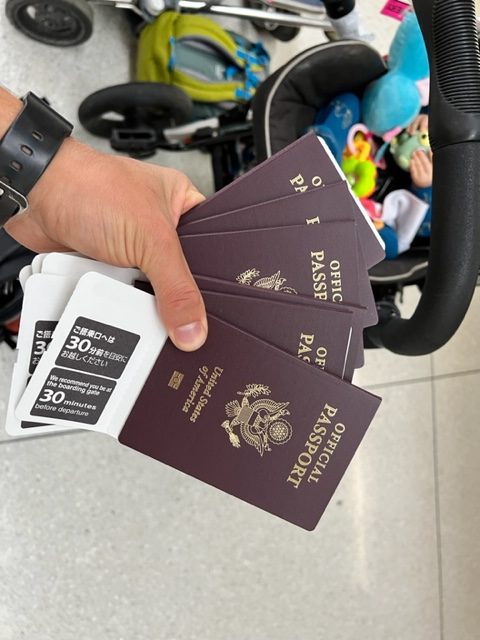
There are a couple different services that can scan your mail for you, but we went with the free forwarding service provided by the United States Postal Service (USPS) to forward our mail to my Brother in Law (I’ve since updated it so mail gets forwarded to my PO BOX at ARMY’s Camp Zama, Japan), and he would tell us from time to time if there was anything important.
I was very worried about international mail for some reason, so I pre-stamped the entire years property taxes and put sticky notes on each envelope for when my Brother In Law should mail them out.
Turns out, we have access to the USPS in the nearby army base, Camp Zama Japan, and postage is the same as being in the US, packages are surprisingly cheap to ship and standard mail just takes one forever stamp. Your friends and family can ship to your Base PO BOX (I was provided one for free automatically through Zama’s In-Processing Process) as well.
Car Arrangements
We have two cars, a 2009 Honda Fit and 2011 Toyota Sienna. I originally wanted to just cancel my insurance and park the cars in my Brother in Laws house. We ended up renting the Honda Fit to a family friend for the year, and needed to keep one car on insurance anyway to maintain our cheap multi-policy discount, also NJ doesn’t allow you to have an uninsured car sitting in a driveway. I bought a windshield reflector for the sienna, anti-rot spray for the tires and instructed my brother in law to use a Battery Tender to charge the battery every once in a while and to drive it around the block every two weeks.
There was the option for the USG to ship our car to Japan, but with the steering wheel on the opposite side and the tiny streets of japan, we didn’t feel it was worth it. We ended up just buying a cheap used 2009 Honda StepWagon minivan for $3000USD (via Credit Card) when we arrived in Japan at a dealer near Camp Zama, and plan to sell it when we leave. There is a large second hand market for cars in Japan, search “Sayonara Sale” groups on Facebook.
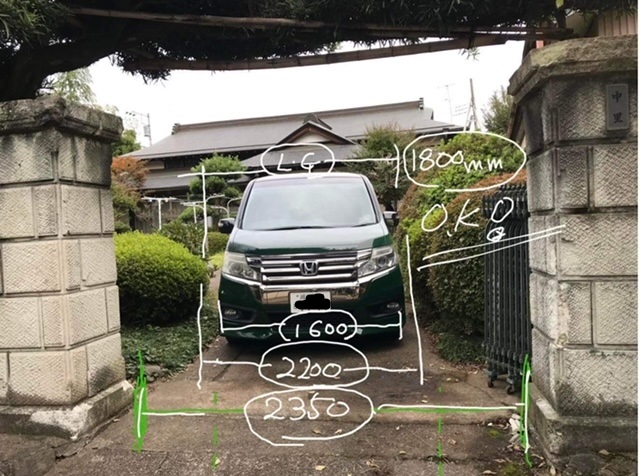
I did receive a SOFA Driver’s License at Camp Zama during my in-processing, but we also went to our local AAA while in America to get our 1-year International Driver’s License for $20. Highly recommend getting an international license as its super-easy, and when we went on vacation to Taiwan I wouldn’t have been able to drive without it, and you can only get it while in America.
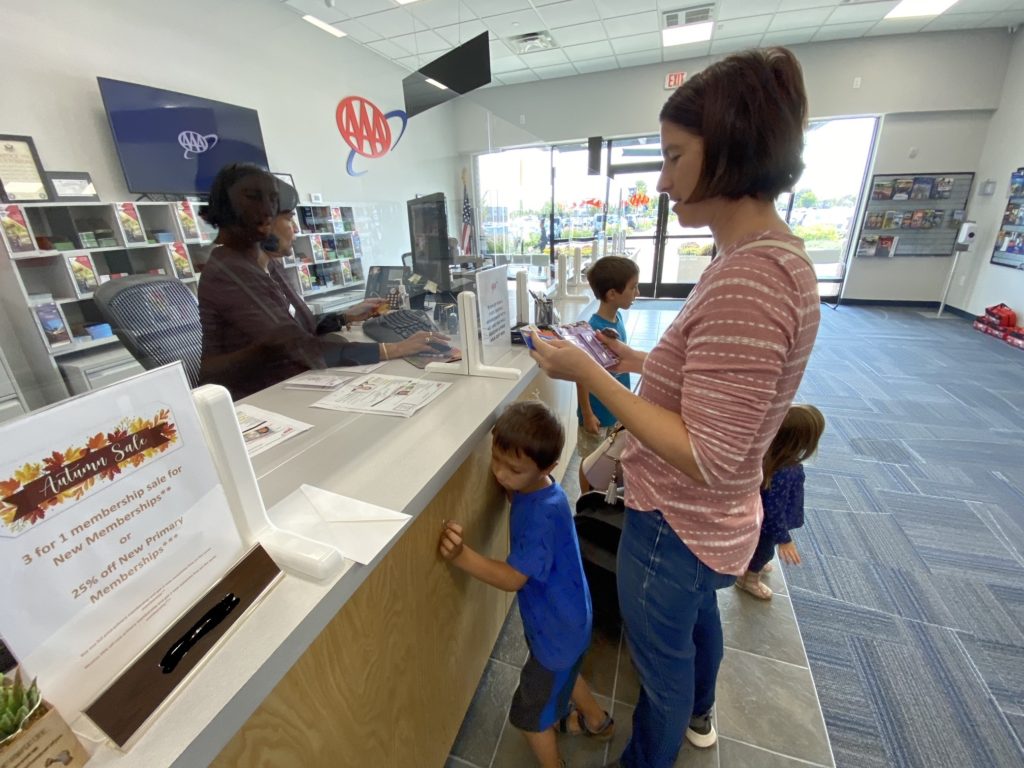
Health Medical Insurance
We chose to keep our regular health and dental insurances, and were just told that anywhere we went in Japan we would be charged as being out-of-network. After coming to Japan, on the few occassions we did make a visit we just ended up paying cash and not showing the insurance card at all… so I decided it would be a good opportunity to switch from my trusty Blue Cross Blue Shield plan to a High Deductible Health Plan (HDHP) with a Health Savings Account (HSA), something I’ve wanted to do for a while for the Triple-Tax benefit (Amazing Investment Tool: tax-free contributions, tax-free growth, and tax-free withdrawals) the HSA provides, and I was paying cash out of pocket for everything anyway.
Medical Costs so far in Japan (All costs are converted to USD equivalent $1USD=¥130)
- Orthopaedic Doctor/Chiropractor for knee: $25
- Tick bite on scalp looked at: $45
- Worrisome looking bump on back:
- Diagnosis: $250
- Removal and Testing and Followups: $1100
- Wrist pain, they took x-rays, and provided treatment: $45
- Chiropractor for back pain and neck stiffness: $50
- Allergy visit and testing: $250
- UTI Gynecologist Visit: $70
Foreign Currency Exchange
For some initial cash, I requested $800 currency exchange from my Local PNC bank, it took about a week for the Japanese Yen Equivalent to arrive. The Exchange rate wasn’t the best (3% Fee), but better than the airport would have given (10%+ Fee).
For additional cash once in Japan I utilized my PNC Debit card at ATMs and Charles Schwabb Debit Card. Charles Schwabb is amazing because they will reimburse all ATM fees, so you are essentially withdrawing currency at the exchange rate with no fees. When I used my PNC Debit Card most ATMs seemed to charge a 220Yen ($1.50) fee and my PNC bank charged an additional $5 fee for international ATM use.
But most times I just pay for things using my United Explorer Visa Card which has No Foreign Transaction Fees… but I would say 15% of the stores in Japan only take Cash…
I have found Wise.com to be the best way to make large ($1000+) payments and transfers, it has small fees (Less than 1% when transferring large sums of money), it is how I pay my rent to my landlord. Directly from my American PNC Bank account to her Japanese bank Account at the exchange rate your find on google.
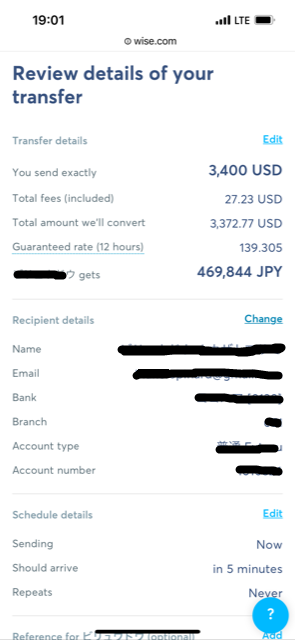
Home and Rental Property Arrangements
Many folks in my situation choose to just let their home residence sit vacant for the year. To me though with all our landlording experience, I felt that was a waste and decided to try to rent the property for the year.
There are a number of things that made this rental more difficult than others: Rental period for a strict 1-year maximum, Renting it furnished, large 4 bedroom home, high rental amount. We advertised on all the usual platforms including Airbnb and furnished finder, and although it took a while and we had to reduce the rental price a few times, we ended up finding an amazing family who had been living in Indonesia and looking to settle back in New Jersey to rent from us. We decided on a Month to Month arrangements with 60-days’ notice prior to vacating; they are looking to buy their own home.
With our other rental properties I had to become a lot more hands off, so I asked my landscaper/handyman who has been spectacular if he wanted to be my Quasi-“Property Manager” (Other Professionals I contacted wanted 5-8% of Gross Income and 10% on top of any repair costs). He already has regular eyes on two of my properties and for the third that doesn’t have grass I pay him $75 to visit it once a month. I then made group texts with each of my tenants, him and I, and told them to contact this group text when issues arose and that my Handyman/Property Manager would be taking care of it. So far it’s been working splendidly, and I look forward to keeping this hands-off arrangement when I return to the states. We have very stable tenants who have been with us for years and we did not increase rents, so do not expect any turn-overs. In the case of turn-overs I would ask my brother-in-law to step in and help, we gave him Real-Estate Power of Attorney before we left.
Cell-Phone
Our cell-phone situation is a little different then most, in that we have T-mobile, and they have a killer international plan (. Free Unlimited Data and Text, $.20/min for calls. (I also heard Google FI plans are similarly very international freindly, and you just pay for calls.) The data is super slow 2g speeds but hey its free, and if I really need high speed data I will buy high speed passes ($50/month). I did end up buying a cheap 1440¥/month sim card through Mobal.com mostly just to have a Japanese cell-phone number which makes a lot of things including getting a Japanese Bank Account easier, but still use my American T-mobile sim card on my main phone, and just threw the Japanese Sim in a spare older phone.
To make calls to each other and to the US, we primarily rely on Facebook Messenger, Zoom, and Iphone Facetime. If I have to call a US company I use google voice which charges $.02/minute.
Foreign Housing
Japan is weird in that their standard-lease is 2-years, they do not provide any appliances with their rentals, and will not rent to you until you are in country. That made things a little difficult, I reached out to several English-speaking realtors through a Japan Expat Facebook Group prior to arriving, but most did not want to really talk to me till after I was to arrive in country, and when others would show me places everything was tiny… and we have 4 kids so we wanted a bigger space, especially given the fact that our Living Quarters Allowance (LQA) for our size family was a relatively high $3400USD/month (More details on how to calculate your LQA in the next section).
A lot of soldiers will live in on-base housing, and if it was available I think that could have been an option for us, but we didn’t want to be in an American bubble for the entire year and the nearest base was also too far from where I would be working.
We ended up finding an Airbnb to move into, we contacted the Host months before we were going to move in, and although our LQA was lower than there monthly fee, they were happy to take us for 11-months at what was the LQA price (LQA fluctuates due to a lot of factors and in the last 9-months being here, has flucuated between covering the full $3400/month rent to only covering as much as $3130/month. LQA gets paid biweekly into my paycheck, see below for screenshot of my paycheck). It was a bit tricky though, as I didn’t want to commit to moving in till I saw the place once we arrived in country. The Host, kindly agreed to block the rest of their calendar from October Onwards until we came and decided we wanted to live there.
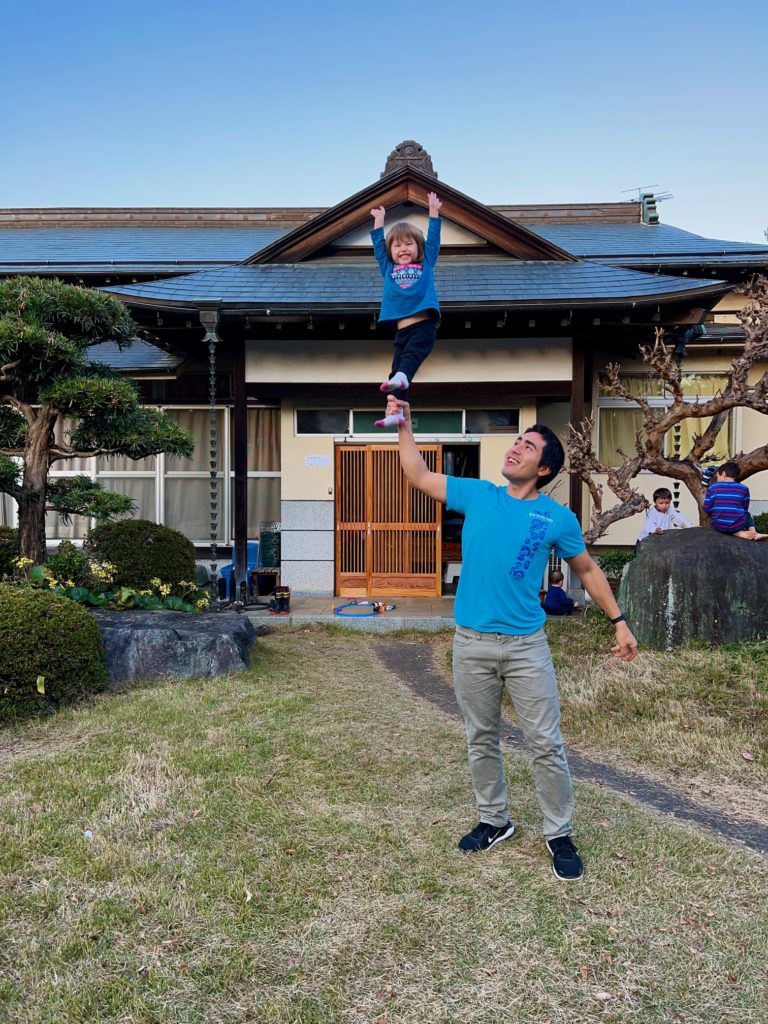
We arrived in Japan on October 4th 2023, we made arrangements to see the landlord and house on October 5th, but not actually move-in until October 15th… I did this so just in case we didn’t like it and would say no, I had Hotels booked through till October 15th that we could stay in while we searched for other accommodations.
Unfortunately, when we arrived the house was still undergoing major renovations and cleaning, in the state it was in we weren’t happy, just seemed dirty and not properly updated, but having just finished a miraculous transformation and cleaning on our own house that we were renting out, I was confident that these 4.8 Star Airbnb Hosts (Also Japanese are known to be fastidiously clean) would accomplish a similar feat…
So a little begrudgingly we agreed on October 5th, that we would move in October 15th and signed the lease, and handed over the $5,000 USD Security Deposit, and Signed up for the required renters insurance.
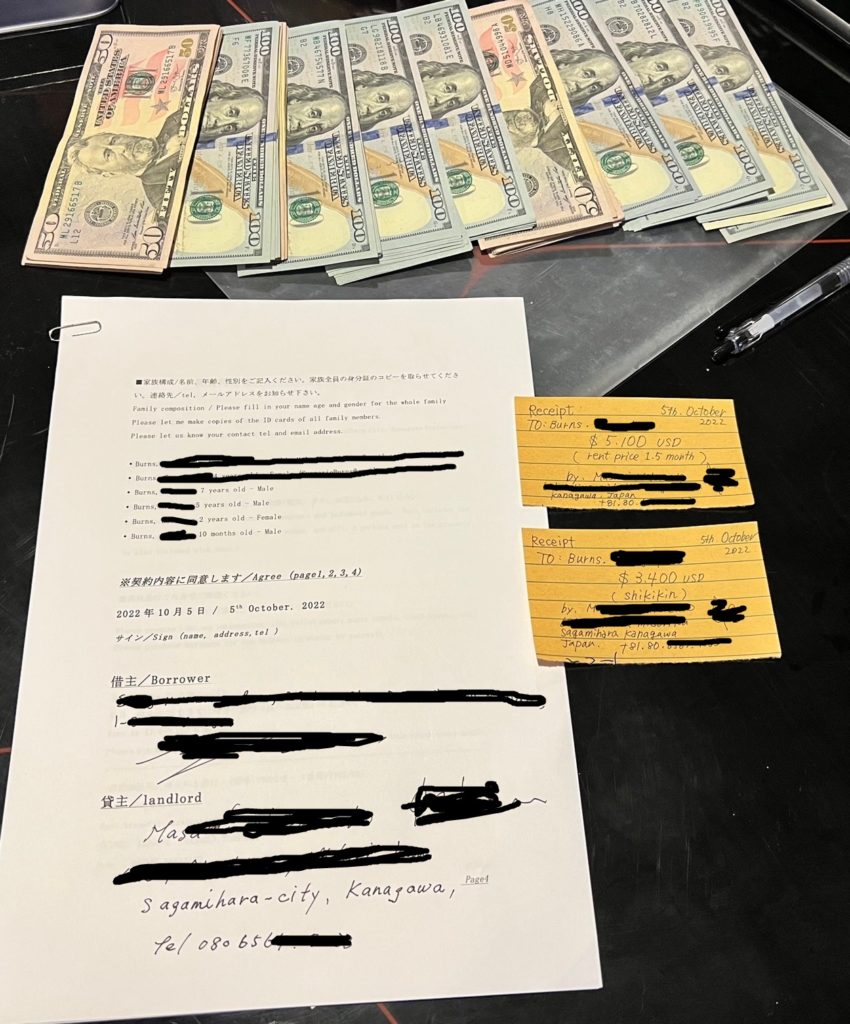
When we arrived to move-in on October 15th we were a little dismayed to find that the landlords family was there busily cleaning the house, some walls unpainted, odd patch jobs, no dressers, random assortment of dusty dishware and glasses, an old forgotten bag of rice with bugs in it… we weren’t too happy, but after a few requests were completed (Replacement of a mildew smelling rug, hiring of a professional cleaner, removal of their families personal effects, purchase of some dressers, and granted permission to use an external storage unit) we started being okay with the arrangement and are now in love with the property… its definitely not the perfect house, but it is such a unicorn of a property for Japan, it has a sprawling backyard that the kids can play in, its big and can easily accommodate our big family, it has parking, it is right next to the river where we can play, it’s a 30-minute bike ride from my work. It came furnished, all the utilities and Wi-Fi were included, so nothing came out of pocket for me.
* Watch this YouTube Video for a Tour of Our 100-Year Old Japan House that we are living in for a Year!
If you are a single person working in downtown tokyo, there is a huge market for “serviced apartments” which are short-term furnished apartmented (usually month-to-month for a maximum of a year). These can often be booked in advance of arrival similar to a hotel. Also many take credit cards for rent payments allowing you to rack up points quick. Another benefit of “serviced apartments” is utilities are usually included at a flat rate so you can make sure it fits under your LQA.
House Hold Goods (HHG)/ Unaccompanied Baggage (UAB)
After reading the above on our troubles with Renting a Furnished Property, you may be thinking why not just have moved all our furniture and rented a unfurnished home?
Well we were told it could take 4 months for our HHG to actually arrive in Japan, and while the Nearby Camp Zama Army Base would allow you to borrow Refrigerators, Washer/Dryers, and Furniture while you waited… they would not lend out mattresses or pillows or sheets, or dishes and cutlery and the various other odds and ends you need to make a household function (and we couldn’t wait 4 months for that stuff, and didn’t want to have to buy 6 mattresses for my family). If you’re a single person it’s probably not nearly as big a deal.
So here are the actual time lines of our HHG and UAB Shipments:
- UAB Shipped out: 30 SEP 2022 -> Arrived 9 Nov 2022 (38 Days)
- HHG Shipped out: 23 SEP 2022 -> Arrived 13 Dec 2022 (51 Days)

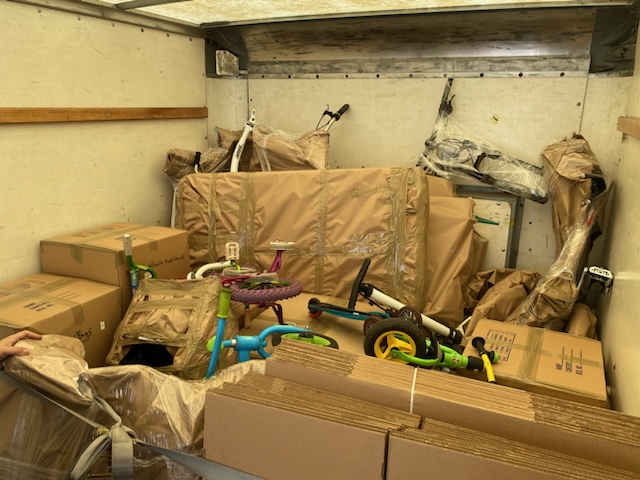
UAB is shipped by Air and meant for non-funiture items that you want to arrive fast (We shipped 900lbs of Kitchen Cultery-Dishes-Pots-Pans, Computer, Printer, Clothes, Shoes, Homeschool Curriculums, Office Supplies)
HHG is shipped by boat and meant for anything including furniture. We Shipped about 1100 lbs of Winter Clothes, a Kids Bunk bed, 6 Bicycles, Books, Toys, Camping Gear, medical supplies. We had shipped some gummy vitamins in the HHG and when it arrived, they had oddly liquefied into one big gloop… not sure if the shipping container it was in just got baked in the sun, or maybe they purposefully heat the containers to kills any bugs and pests that might be with your stuff.
So we had two different moving companies come to box-up and ship out the HHG and UAB, we gathered all the stuff we wanted shipped and put it in the Garage of our house for them to take. Not necessary, but I think the movers were grateful for it. They spent a few hours packaging everything up in the driveway. Someone from the Army stopped by to make sure everything was going okay. Once they are done they present you with an itemized list that you sign to make sure everything was accounted for, and you are supposed to label the high value items. Everything was delivered well, except we lost one bar for one of our child bike mounts, and there was some packaging tape that melted itself onto one of the bikes, other than that and the melted gummy bears everything was perfect.
Our family of 6 was allotted a total of 18,000 lbs (Your limit should be listed on your orders) to ship, only used up about 10% of that, but the way we have been buying souveniers and frequenting the thrift stores here in Japan, I think that will probably grow considerably (My wife likes to frequent all the Second Hand Thrift Stores in Japan…) on our shipment back home.
You arrange the shipment through a website https://dps.move.mil. And it seems once the move order has been received your request gets bid on by various moving contractors in your area. Once they sync your request up with a Mover they will email you to notify a match has been made and what the expected date for pickup is. I also received calls from the moving company themselves to confirm scheduling. I did not have to be home, my wife could sign all the moving paperwork herself. For the HHG we had a company and date confirmed in one-day, for the UAB it took about 4-days to get someone finalized (It was the end of the month and we didn’t give them much notice… 7-days before our flight).
DFAS, Money & Reimbursements
When moving abroad, there is a ton of expenses and forms to be filled out, and receipts to turn in, and changes to your Salary. I will attempt to capture all that in this section.
For a majority of reimbursable expenses you will be using your Government VISA Travel Credit Card. One tip, is to call your Travel Card Admin and ask to put your Government Credit Card on “Mission Critical” Status, this makes it so you pay no interest for 90-days. this is helpful because you likely will not start seeing reimbursements for about 90-days.
Plane Tickets: This was the first Travel Card Purchase which I booked through Carlson via phone about 45 days before departure date. I was told departure date should be in the new fiscal year, so that’s why we flew out October 3rd 2022. My card didn’t actually get charged till a few days before the flight, so you don’t have to worry about reserving early and interest accruing.
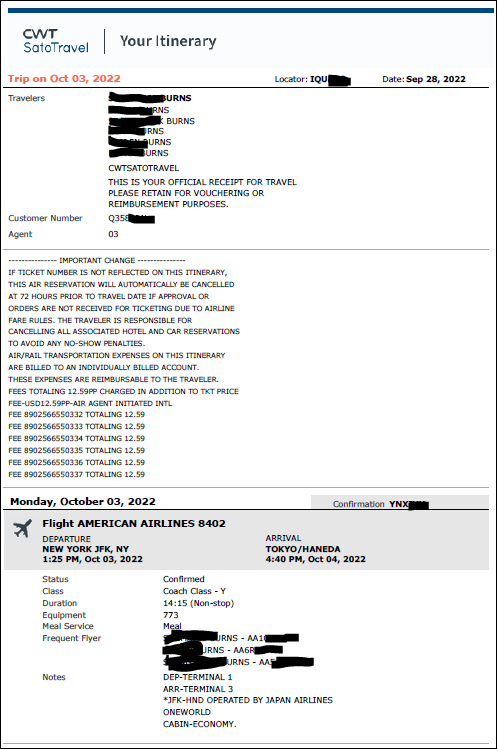
En Route Travel: Travel to the airport is reimbursable and per diem is provided. These expenses and the airline tickets, and a $1300 ($650 if no dependents) Miscellaneous Expense Allowance (MEA) get reimbursed through the DD-1351-2 Form, and should be sent to your supervisor upon arrival in country… like most reimbursments this will be paid out through your normal biweekly paycheck.
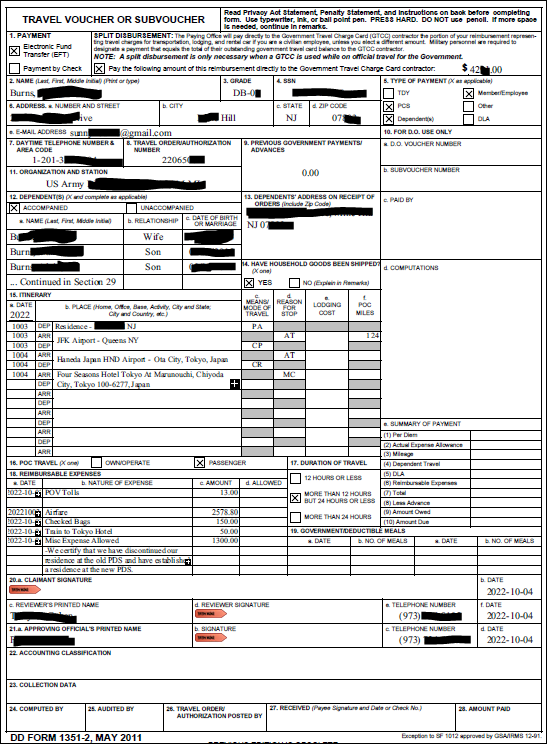
Temporary Quarters Subsistence Allowance(TQSA): You usually get a maximum of 30-days of TQSA, and it is generally for the purpose of reimbursing your hotel, meal, and laundry expenses while you look for permanent leased-lodging. Our TQSA ended up being very large with our big family, and we were being allowed up to $600/day (To calculate TQSA you need to figure out the per diem rate of the area you will be going to and what percentage you and your dependents get for you stay). This allowed us to experience nice accommodations we wouldn’t typically frequent, we were hoping to try some good restaurants too, but didn’t seem like there were many kid-friendly options. You are supposed to submit receipts for any expense over $75 USD, but I kept receipts for everything, and got to dry-clean all my suits and shirts too! We only used TQSA for 14-days, at which point our Airbnb was “ready” to move into and we applied for Living Quarters Allowance (LQA). To submit reimbursement for the TQSA you need to fill out a SF1190 and DSSR 120 and attach all your receipts.
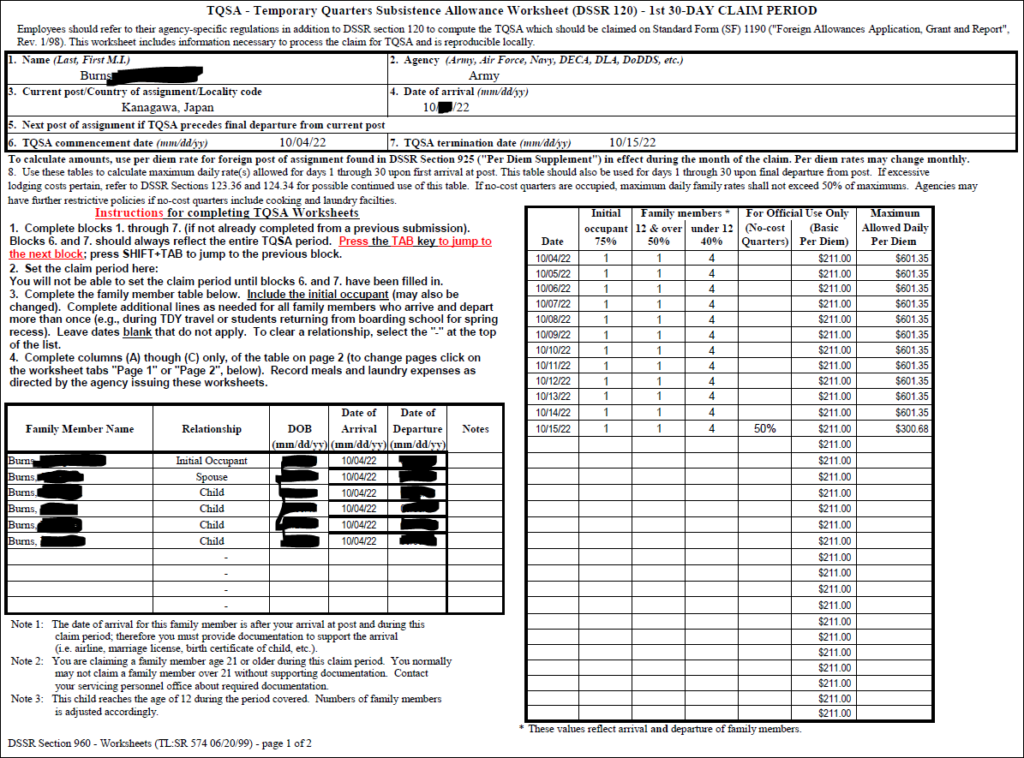
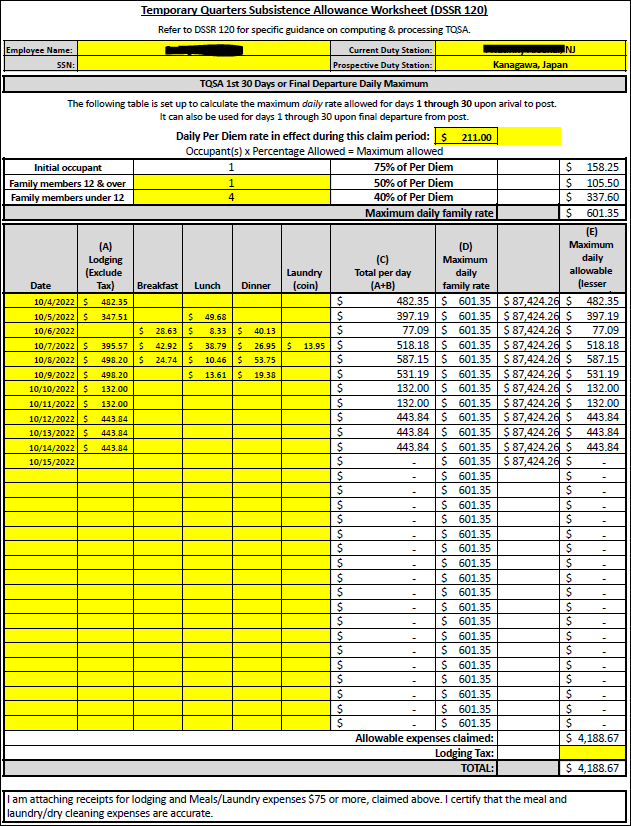
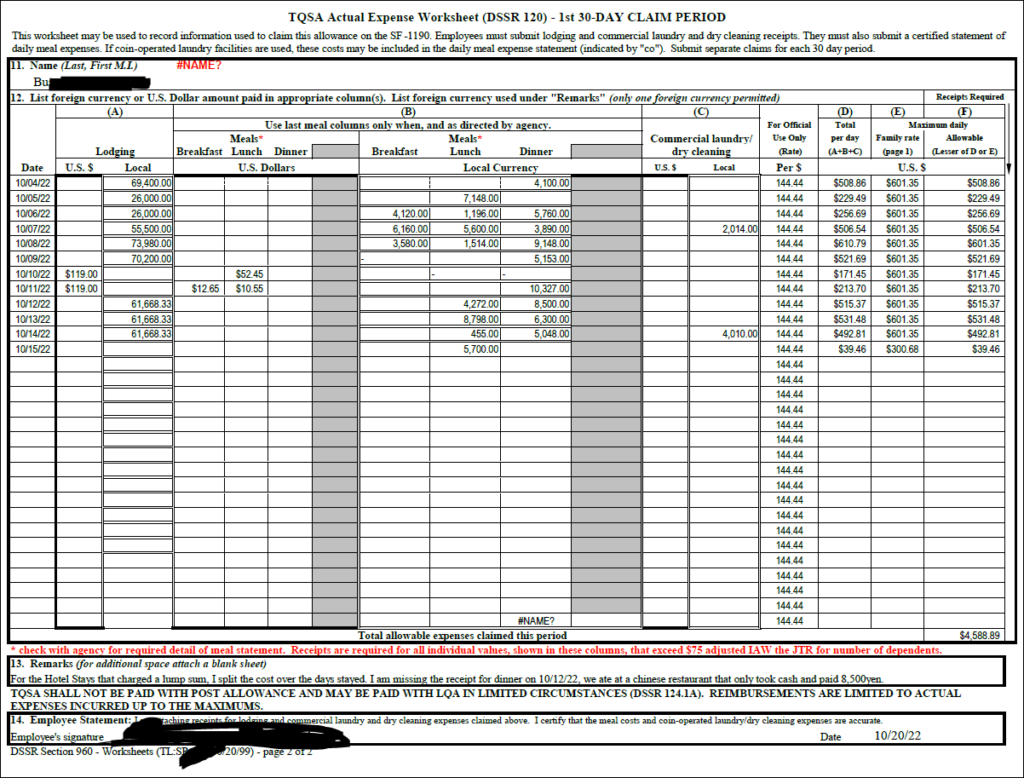
Salary Change: When you go overseas you will lose your locality pay (35% increase from Base Pay in NJ); what you get instead is Living Quarters Allowance (LQA) and Post Allowance (PA).
My Base Pay is around $90k, with locality my full-salary is usually around $120k. So that is a $30k loss.
But PA (https://aoprals.state.gov/Web920/cola.asp) is about $15k for my family of 6 in the area of Japan we are living. So really a $15k loss from my Full Salary. Another benefit to PA over Locality is that it is untaxed!
But with LQA (https://aoprals.state.gov/Web920/lqa_all.asp?MenuHide=1), as long as I am below the Maximum reimbursable amount of $3400/month for my rent is fully covered, so it is kind of like an extra $40k a year, especially if you are renting your personal residence back home and have those typical costs covered. So I am actually making about $25k more than my full-time salary in Japan.
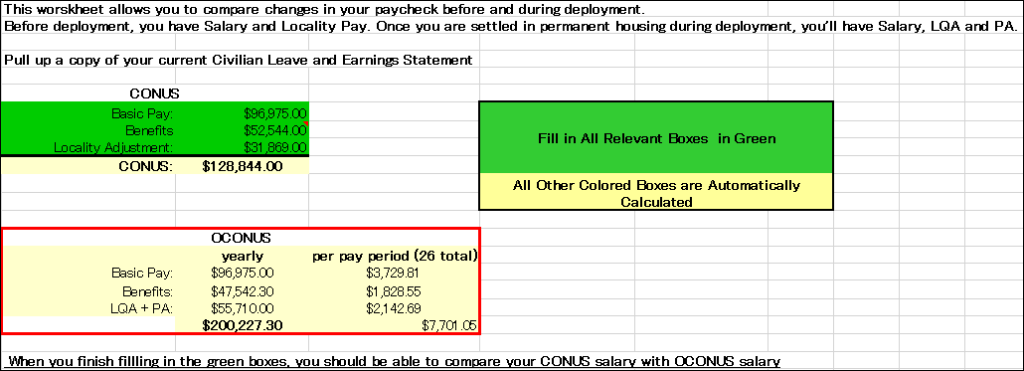
Our home in New Jersey is also being rented out for $3400/month, our mortgage, property taxes, and insurance are about $2400/month, so we are profiting about $1000 more a month because of this, not to even consider the utilities we normally have to pay (tenants pay their own utilties).
So I would say by going to Japan, from a financial perspective we are able to save about $3,000 more a month than we typically do… probably a little more since the USD to Yen is super strong right now and the cost of living is significantly cheaper in Japan, $7USD gets you a fabulous meal in Japan and the best part is Tax is usually built into the price and there is no tipping at restaurants!

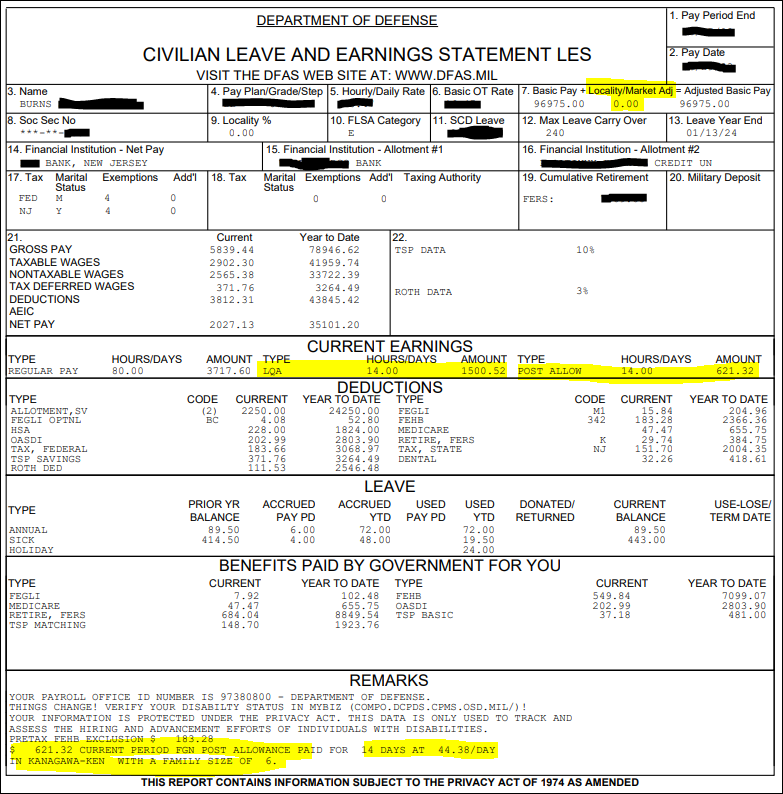
To receive LQA and PA in your paychecks you are going to have to fill out the SF-1190 and DSSR 130. You will need a signed lease agreement to send with this submission.
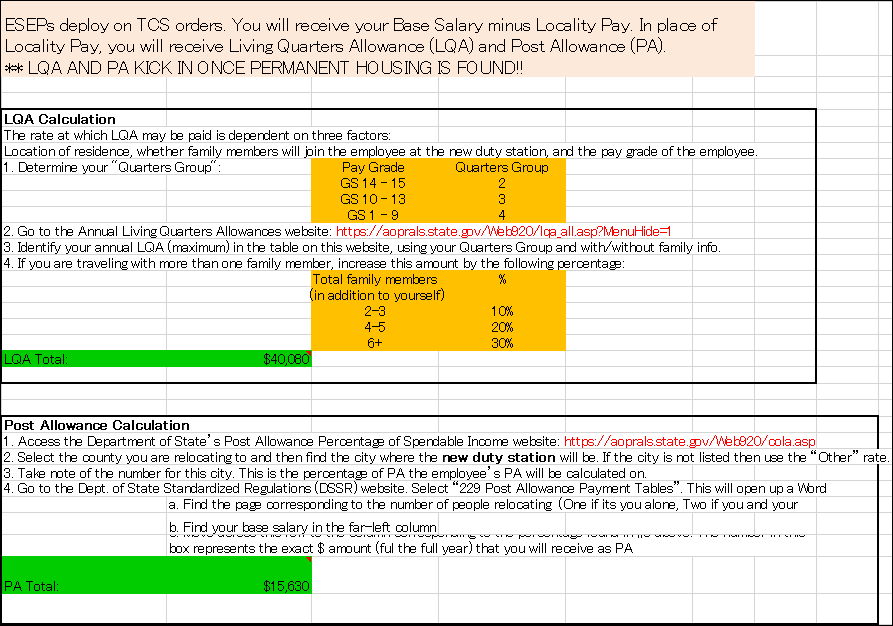
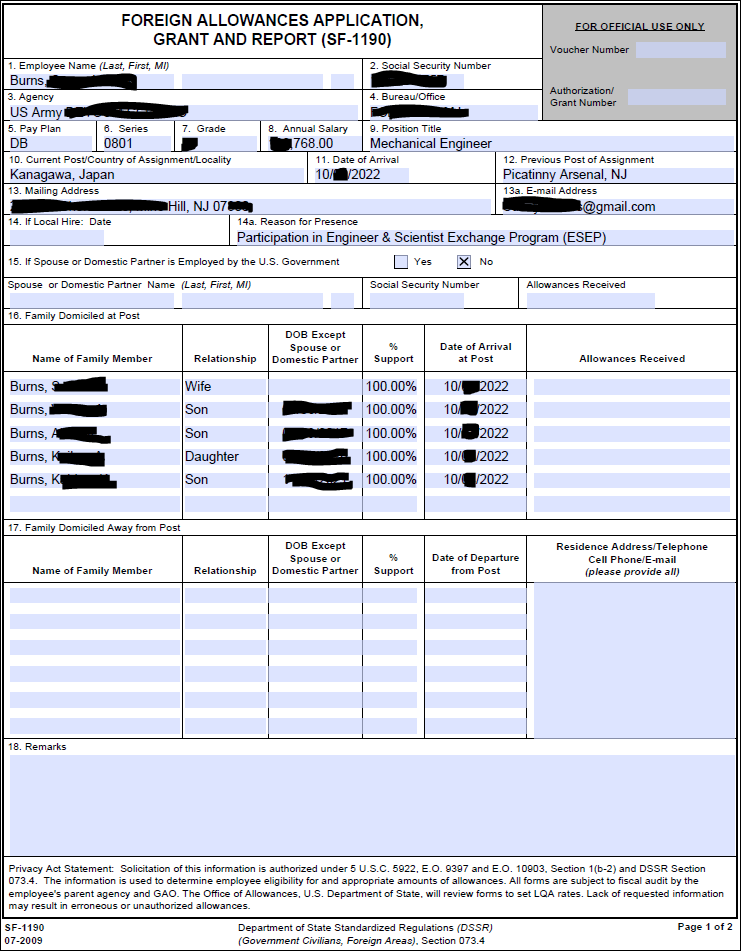
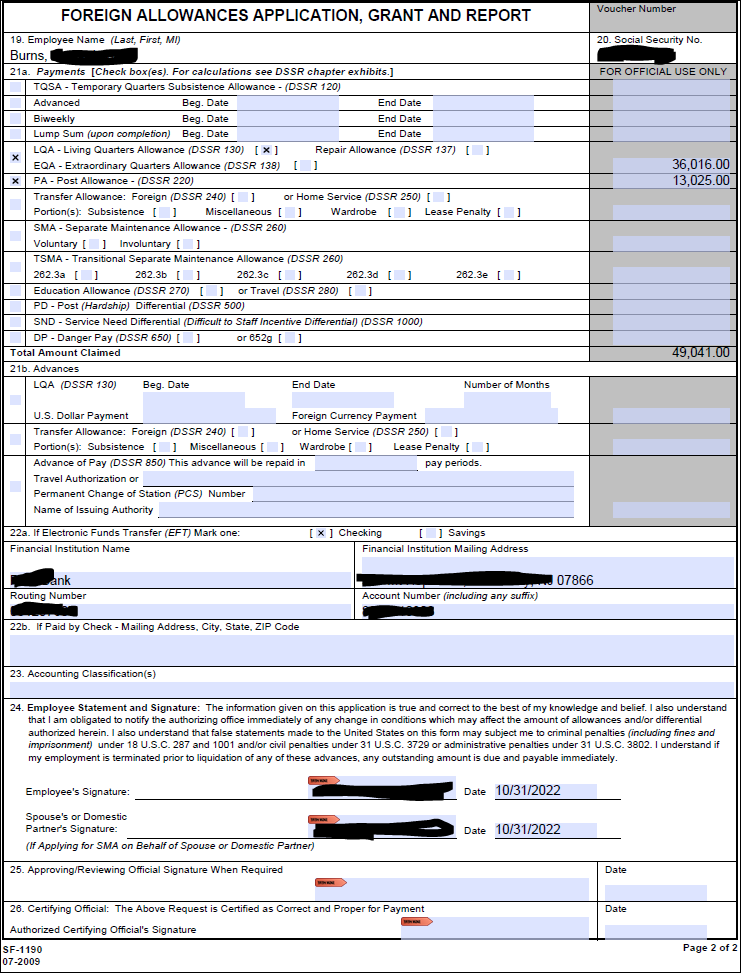
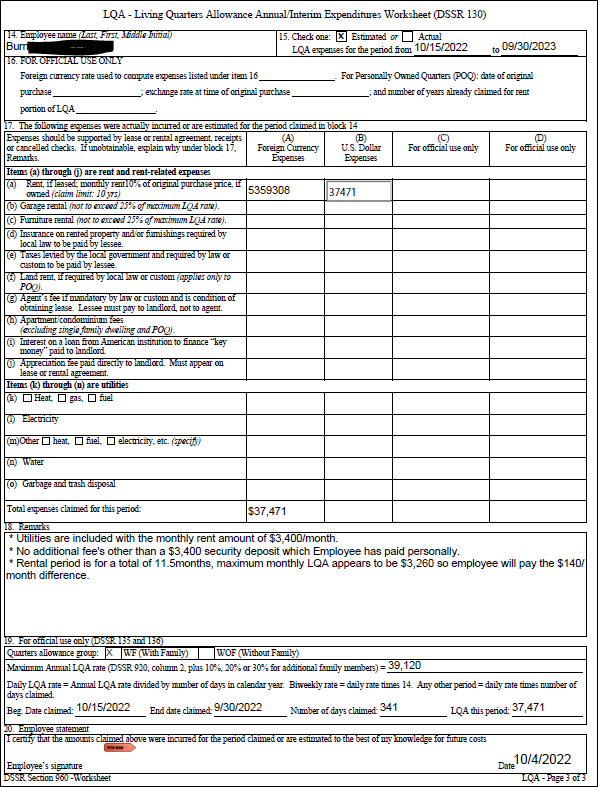
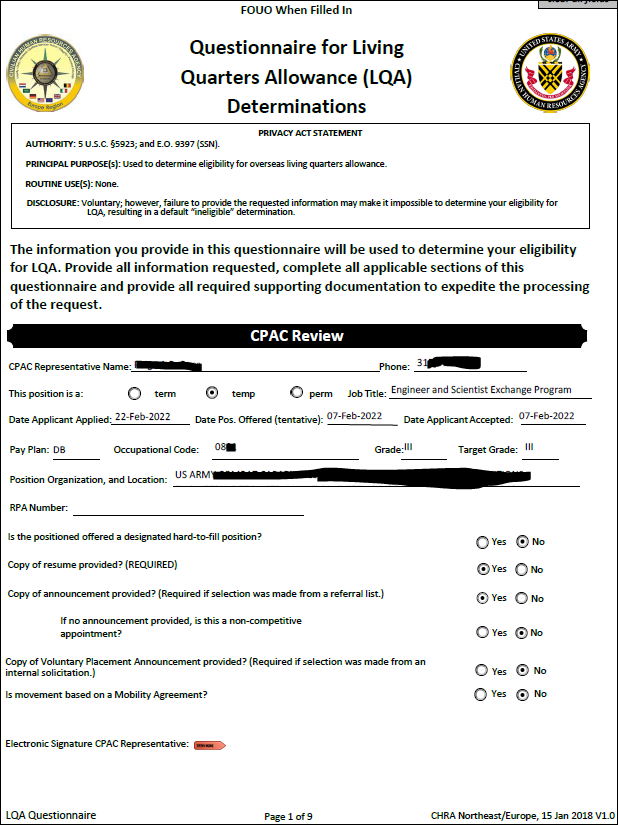
IN-Processing at Camp Zama Army Base in Japan (OCONUS CAC)
Within a few-days of arriving in Japan, I went to go In-Process at Camp Zama, it was about a 2-day process and we stayed for 2-nights at the Inn at Zama ($132/night). The biggest thing we did for in-processing was getting an OCONUS CAC (Form DD1172). They took my old CAC and provided me a new OCONUS CAC that is only good for the 1-year I am here. The OCONUS CAC gives me special permissions like using the Base Exchange, Commissary (Usually cheap shopping and can find goods like peanut butter, toiletries, and OTC meds that are not commonly found in Japan), MWR and other privileges like SPACE-A travel (Discussed more at the bottom of this post) that are not typically afforded to CONUS DoD Civilians. I will have to get a new CAC when I return to the states. I was afraid my DoD Webmail might not work after getting a new OCONUS CAC, but everything worked fine.
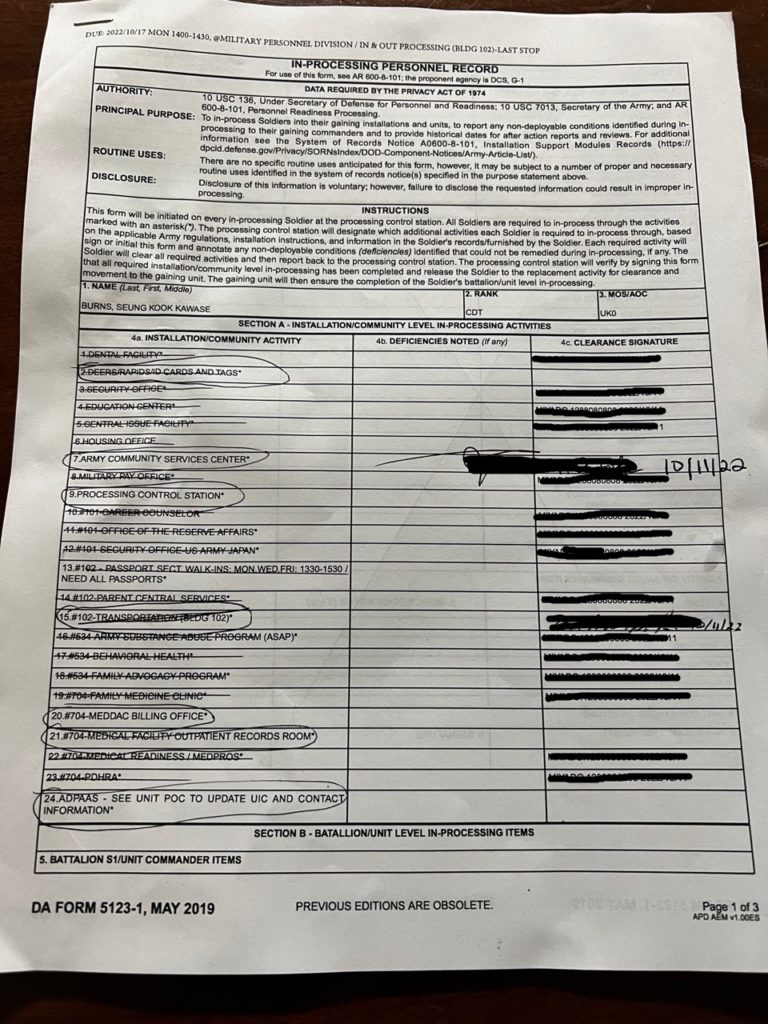
My wife also got a CAC for the first time, a dependent CAC which allowed her to come and go onto any of the military installation as she pleased (turned out very useful, and she goes weekly to a women’s group at Zama on Thursday mornings).
This was also when we registered with the post-office and got our PO BOX, and I sat in on the SOFA Driver Training and got my SOFA Driver’s License.
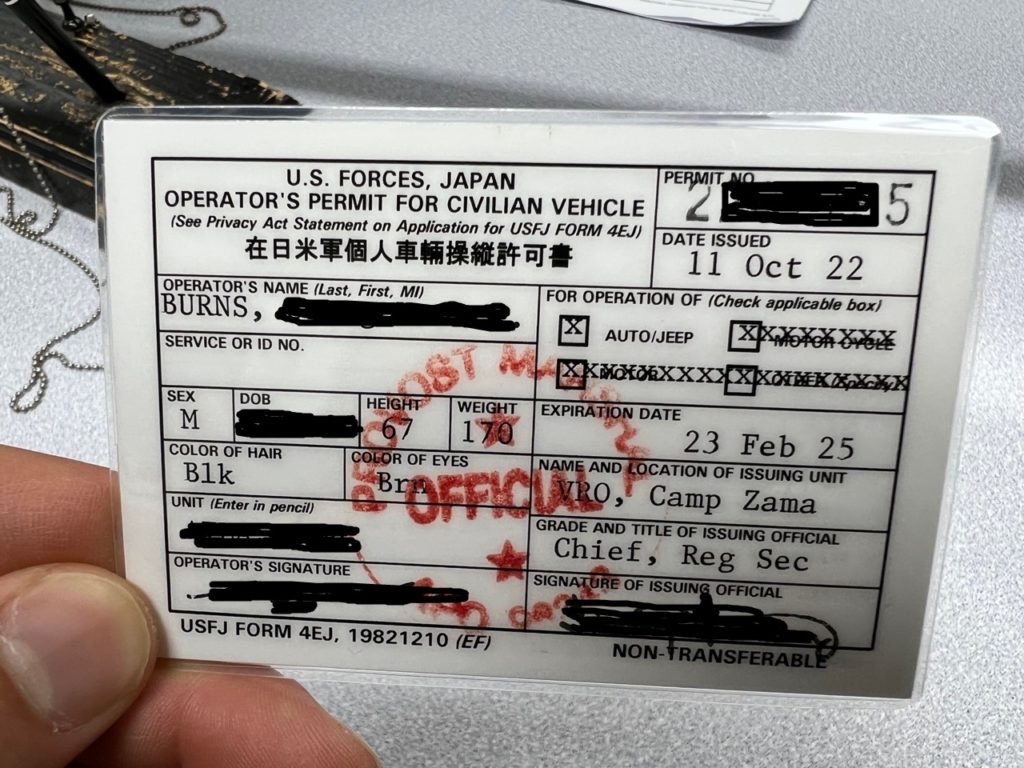
Camp Zama Military Base in Japan Facilities:
Camp Zama has a grocery store, gas station, outdoor pool, Indoor Pool, Full Size gym with classes and 4 full-length basketball courts, indoor track, hot tub, steam room, and Sauna. Has its own Inns you can stay at, library, restaurants, PX, department store, home & garden store, rental car company, MWR facility, Post Office, Bowling Alley, & Movie theater. It seems like a very enjoyable place to live.
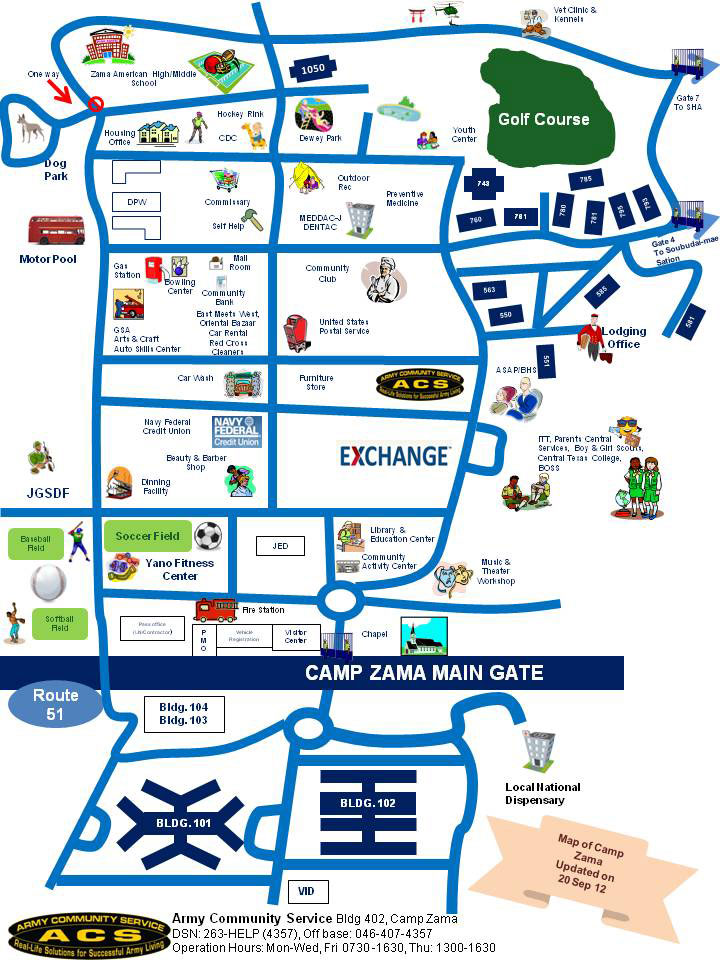
Overseas Schooling for my Kids
We had several options regarding school for my then 5 & 7 year old. Continue to homeschool, enroll them in the “local” DoDEA school (John O Arnn Elementary School in Sagamihara Japan), enroll them in the local Japanese public elementary school, or find a private school (International) that hopefully the GVT would reimburse.
We ended up enrolling them in the local Japanese elementary school, which was only a 8-minute walk from our rented home. We like homeschooling our kids, but felt it would be a shame to keep them in a English speaking bubble while we had this opportunity to be immersed in Japan. My 7-year old son having started with no Japanese at all, can now read very well although he doesnt really understand what he is actually reading. Even though he is the only non-asian student in the school, he has made many friend and enjoys his time at school, he still struggles with chopsticks at lunchtime.
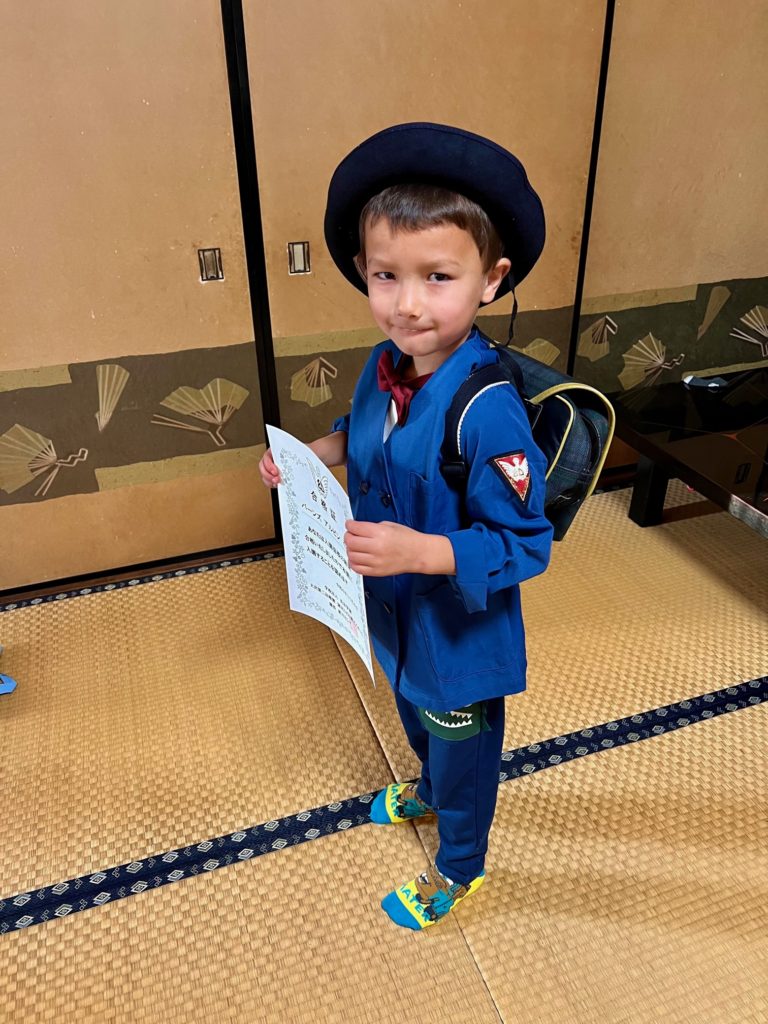
Kindergarten in Japan is considered Pre-School, and is private, so there is a fee to send your child there. In April my now 6-year old son graduated and entered 1st grade public elementary school, the same school as my older son, they together join the walking group from the house and walk themselves to school. During the 5-months he was in the private kindergarten though we had about $800 total of expenses, which we tried to request reimbursement for from the Non-DoD Schools Program(NDSP), but they shot us down even when we submitted a formal appeal saying we were within the “1-hour” commuting distance, which we clearly showed was not the case. Anyway just glad we didn’t opt for an expensive international school.
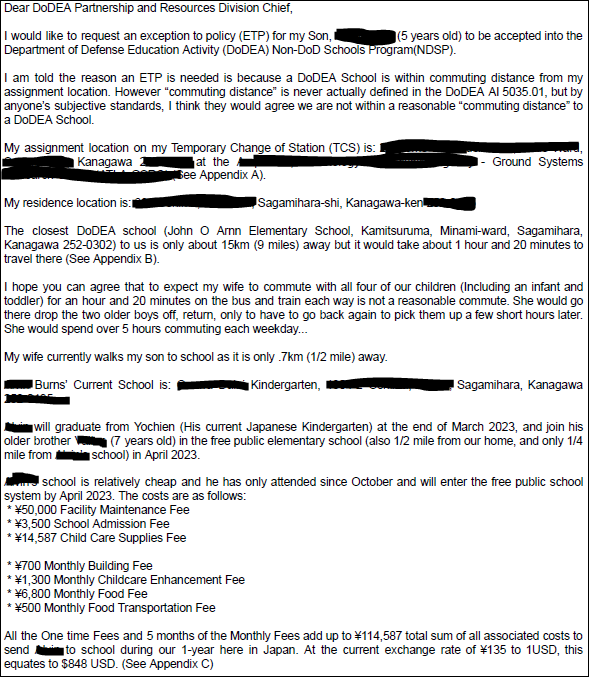
Unexpected Perks
Below are some unexpected perks about living in Japan that I didn’t realize or think about:
- Could travel cheapily to destinations (Taiwan, S. Korea, Okinawa) we wouldn’t have considered from our NJ Home Base.
- I buy lunch everyday, because it is so cheap and good in Japan, something I enjoy very much and never did in America. We also go out to eat as a family, at least once a week, our go-to is converyor belt sushi.
- Cost of Living is a lot cheaper in Japan, no tipping, escaped U.S. Inflation, USD to Yen is at a 25 year high!
- Access to all the DoD bases in Japan, cheap gasoline, MWR activities and Rentals, including cheap luxury New Sanno Hotel in central tokyo.
- Access to DoD Facilities with lodging in Tokyo Area of Japan: New Sanno (Tokyo), Hardy Barracks (Tokyo), Tama Hills (Tokyo), Zama Lodging, Misawa Inn, Kanto Lodge in Yokota, Mountain View INN at Fuji, Atsugi Inn, Sasebo Inn, Yokosuka Inn, Ikego Campgrounds near Kamakura
- Cheap US comprable shipping through Military Base USPS
- Space-Available free flights (more details below)
- Could rent a bigger place, to accomadate family and friends that visited throughout the year
- Wife was able to get a dependent CAC card and enjoy going to a weekly bible study group on base, as well as shop the commissary, go to the base library, gym, etc.
- Access to DoD Library, and digital Apps like Libby
MORE TCS/ESEP Specific Topics
Thank you for reading up to this point, below is more specifics on my personal assignment as an Engineering & Scientist Exchange Program (ESEP) Exchange Engineer.
Accessing DoD Work Emails & DoD Sites
I think some organizations will provide you with a DoD Laptop to take with you on your travels, in my case however I did not get one… but by getting a CAC card reader I found out I could get my personal computer to access things like DoD webmail, MyPay, EBIS, and could view and respond to all my unencrypted work emails. I usually only check my emails once a week, and send an Excel time sheet to my DoD Supervisor with my Japan Supervisor CC’d once a week.
While away for the year, I set-up an Out-Of-Office on my Outlook and Teams account (“I’ve TCS’d to Japan on an ESEP assignment and will be checking my emails very sparingly. I will be back at Picatinny in October 2023. Please reach out to…. If you need to get a hold of me, please reach out via my personal email…”), and my supervisor made it so I didnt have to do trainings…
US/Japan Holidays
So this was a bit annoying, I think anyone PCSing and working at Camp Zama would just take the normal (11) US Federal Holidays, but me working at a Japanese Military Research Center, the place is shut down on (16) Japanese Holidays. My Japanese Supervisor graciously offered to let me take both Japan and US Holidays… but my DoD Supervisor wouldn’t hear of that, and made me choose… not really a choice since the Japanese Workplace was shutdown on those 16 holidays… So to my disappointment, I am taking the Japanese Holidays, but only 11 of them are being covered, and I am being forced to burn 5 days of annual for the remaining holidays… I hope other supervisors can be more accommodating.
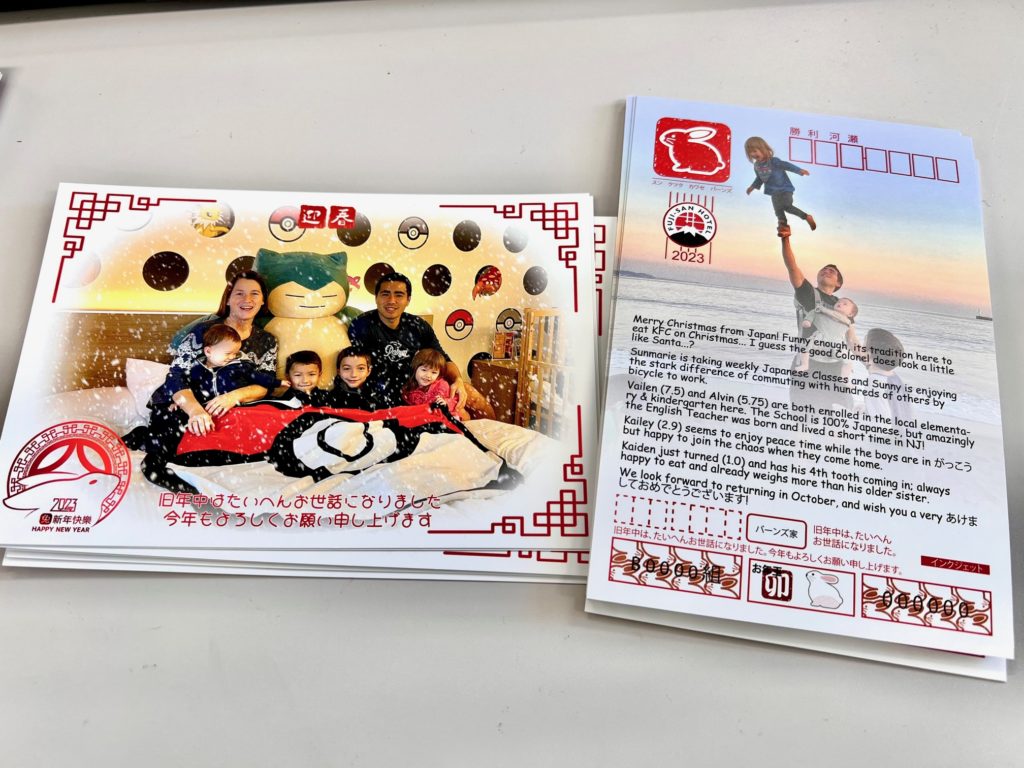
Japan Work-Hours
I didn’t start working as soon as I landed in Japan, I was given a few weeks to in-process at Zama and get housing and other things like schooling for my kids in order.
In America I would work from 0700-1630 9 days every 2 weeks (Flex time with every other Friday Off). My Japanese Office doesn’t have such a policy and in general start much later with official 7hr 45min days and usually 1 hour lunches… my DoD Supervisor told me I had to work 8-hour days… so currently my work hours are 0730-1600 every day and a 30-min lunch from 1200-1230. My Japanese supervisor emails an excel timesheet to my DoD Home Supervisor every two weeks. If I happen to go out to eat or have an extended lunch, my Japanese Supervisor just lets me make up the time at the end of the day. The Japanese are known to be relentless hard workers, and I think that is the case, I have never seen anyone go home, I am always the first to go home.
One evening , I watched an eclipse with my kids at 8pm… the next morning I asked if anyone had seen it, and they said they had, and that there was a good view of it from the office window…
Japanese Work-Environment
My work is at a Japanese Ministry of Defense Facility with about 200 civilian engineers who design armaments for the Japanese Self Defense Force. It is a secure facility with a gate guard who checks everyone’s ID when they enter. There is about 30 building in the 10 Acre Facility. I as an ESEP am only allowed unescorted into my building, and then every door in my building including the bathrooms are labeled with green ESEP-Allowed signs or red ESEP-Restricted Signs… I pretty much only use the Men’s Room, Locker Room, and my office room. My office is shared with 4 other engineers including my supervisor. I have my own desk, with two drawers and desktop computer with a single monitor and a desktop phone which I never use.
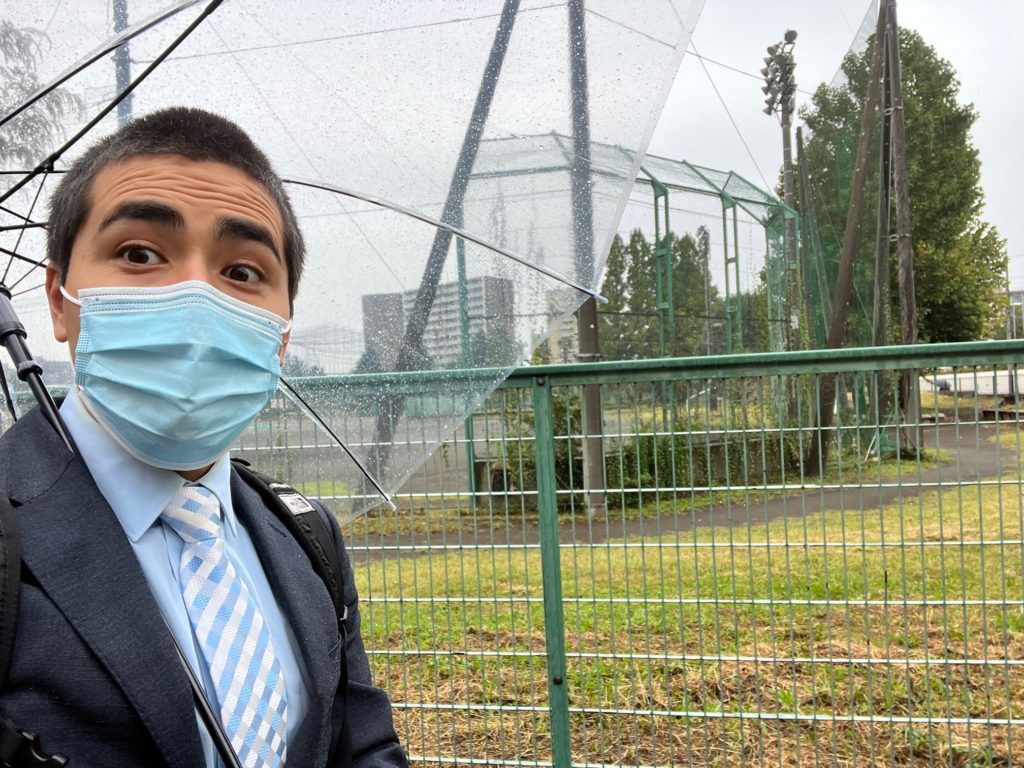
It is a Dell PC which they allowed me to change the language to English, although 99% of my work emails are in highly technical and advanced Japanese and I just ignore it. My Japanese supervisor points out any important emails I should pay attention too. The keyboard used in Japan is almost identical to a US keyboard except it has Japanese letters overlaid on it, which can be toggled on or off.
Dress Code is business or work-uniform coveralls. Dress Shoes are optional though, a surprisingly large percentage of workers wear a tie and slacks and sandals in the office…
My Japanese Supervisor, is one of a few people in my building that speaks decent English (and its improved rapidly since I have been here), others have a few words but usually require coaxing to try. I talk to my supervisor much more than anyone else in the office, and our general agreement is he talks to me in English and I talk back in Japanese, that way we both improve.
Commuting to Work
Majority of workers in Japan commute to work by Train or Bicycle. At my office, if you want to drive you have to apply for a parking permit. I have been biking to work every day, rain or shine, freezing or hot… it is amazing to see the Japanese people astride their bikes in full suits as they commute to work. When I arrive at work, I park my bike by my building and go to the locker room, where I change into my business casual attire. If I am sweaty, I will take a shower in the shower room first. For some reason, Japanese People generally do not wear helmets while riding their bicycle, and often times when its raining you’ll see them one-handing the handlebar while the other hand holds an umbrella.
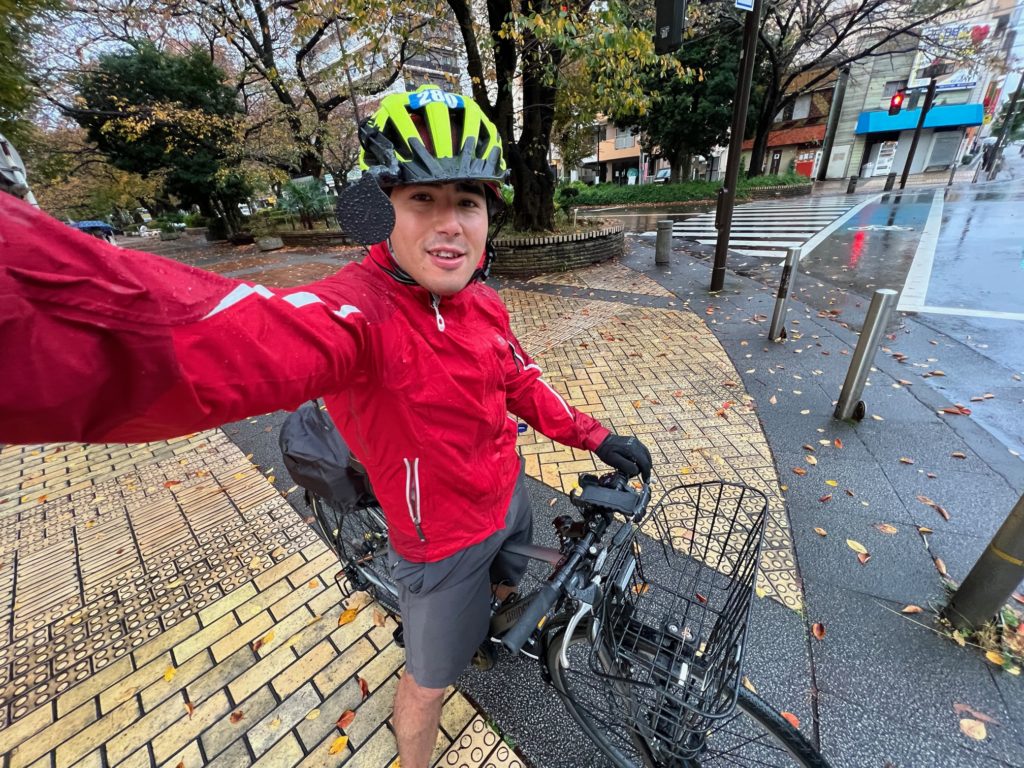
Its funny to me, but japanese people feel it is important to dress nice while commuting, although they do not care about fancy shoes and running sneakers are a common sight with dresses and suits. Many coworkers commute all the way to work in a business suit, only to change into work-uniform coveralls when they get here… I really dont get it.
My first day at work it took me over an hour to bicycle to work (7 Miles), used my landlord’s cheap folding bike and there were an insane amount of redlights. Then my supervisor made me a Powerpoint presentation with turn by turn Google Map Streetview directions… this brought me down to about 45 minutes. Then I bought a used Mamachari 2-child e-bike on Tokyo Craigslist that got me down to about 40 minutes. Then I bought a Bridgestone TB1E Electric Commuter bike off the https://jmty.jp/, which is a japanese classified that is much more popular than craigslist, which got me to around 35 minutes. I then bought a used 2021 Carbon Giant Revolt Advanced 2 off FB Marketplace and am clocking into work at around 28 minutes!
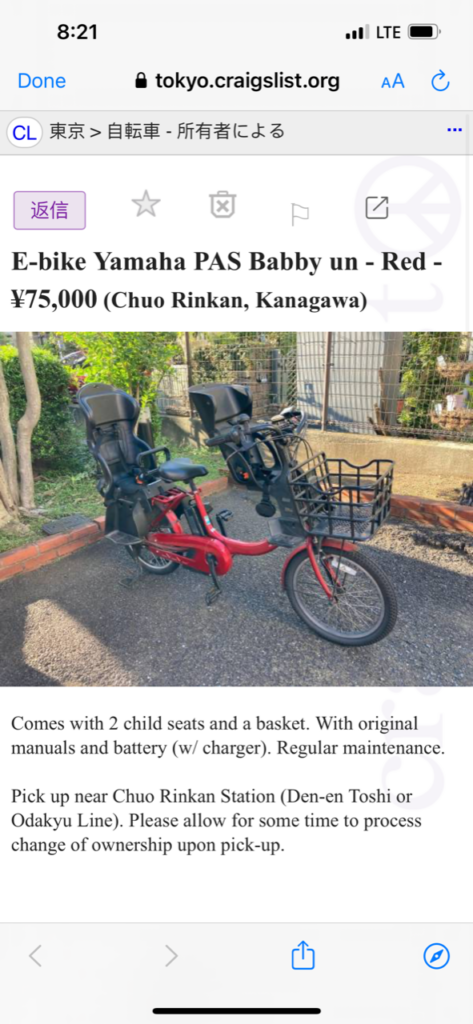
What I Do at Work
I will be brief here as I don’t want to disclose anything I shouldn’t, but I have mainly been working on improving the Insensitiveness of Munitions by running Modeling and Simulation (M&S) in different scenarios.
I didn’t really know what I was going to be doing prior to arriving, I only had a broad sense. When I did arrive, none of what they wanted me to do was in my expertise, but they gave me time and provided resources to learn how to perform my duties and I am now the resident expert at M&S. I do not feel too much pressure at work, it is a pretty relaxed and easy going environment, and other than a few unusual occasions, I always go home on time at 1600.
Space-Available Flights
On 2 December, my wife and I and our 4 kids flew out of Yokota AF Base on the Patriot Express (Very Similar to Commercial Aircraft, with stewardesses, lunch, etc.) to Kadena AF Base in Okinawa. The Plane did make a stop in Iwakuni Japan first to let off/on some passengers. We flew back to Mainland Japan on 11 December also on the patriot express, I was hoping to catch a smaller military aircraft for the experience, but there were no missions with space-available going out the week we were there.
I needed three signed forms in order to use Space-A as a DoD Civilian working overseas. My Orders (TCS/PCS), EML (Environmental and Morale Leave) Form, and OPM 71 (Request for Leave form).
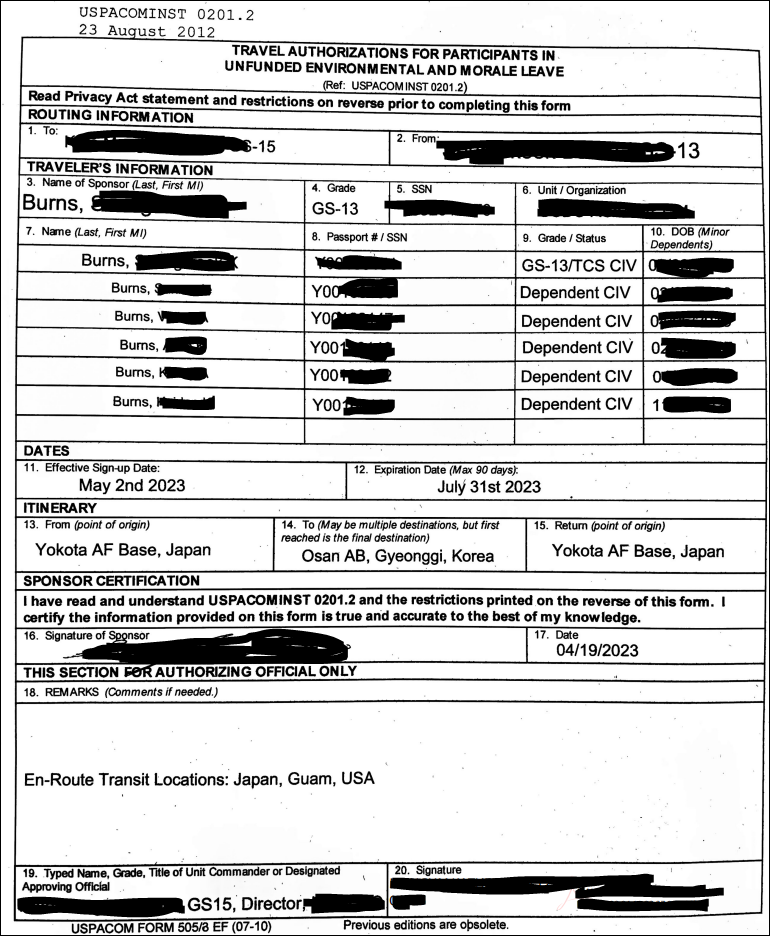
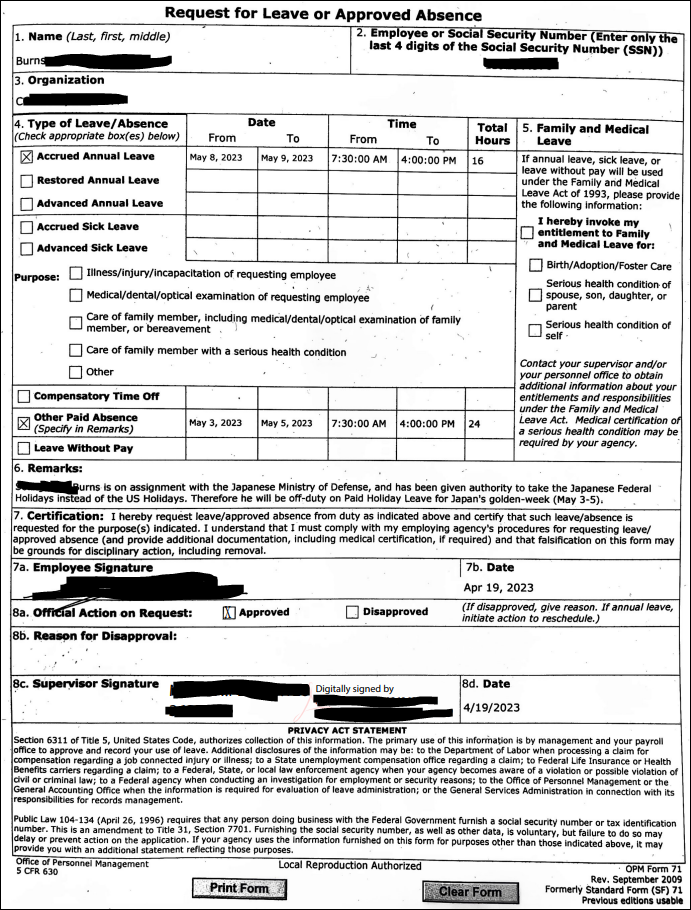
Once arrived at the passenger terminals of the AF Base, I had to show these three forms, as well as my wife and I`s CAC card, and all 6 of our official passports (When we flew Space-A again to Korea, they wanted to see the regular US Tourist Passports… so my advice is just bring both!).
Space-A is a privilege and not guaranteed, we didn’t get confirmed boarding tickets until 2 hours before the flight took off. On the way out there was 119 seats available, 8 of which were taken. On our flight home there was 44 Seats available, 9 of which were taken.
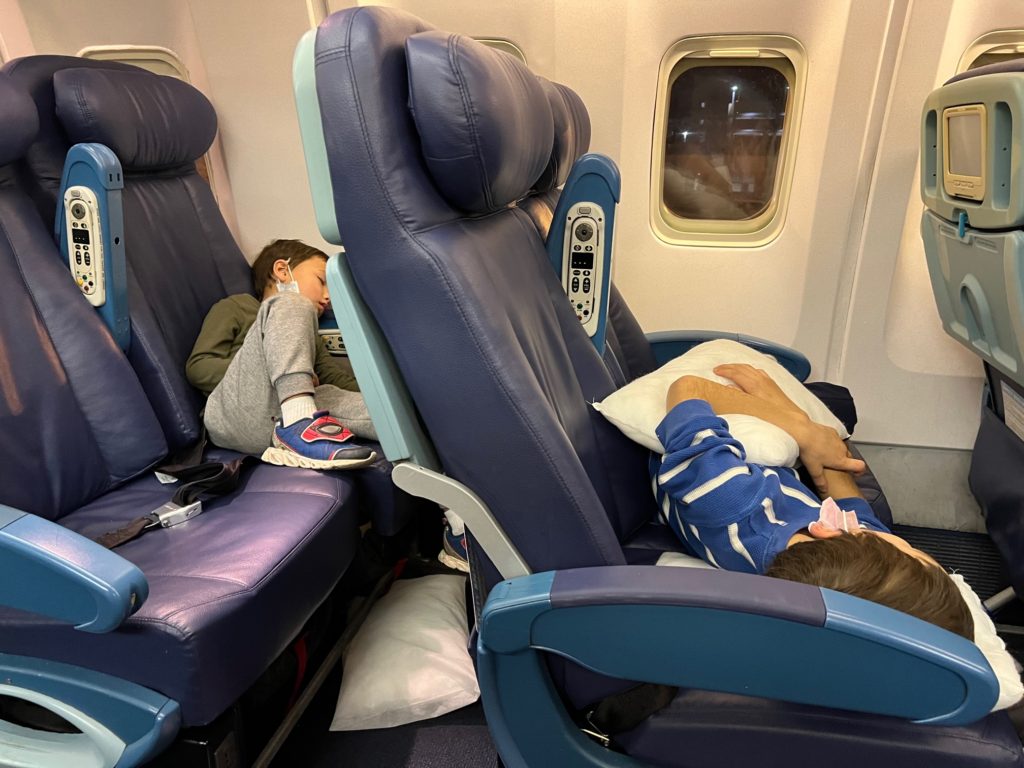
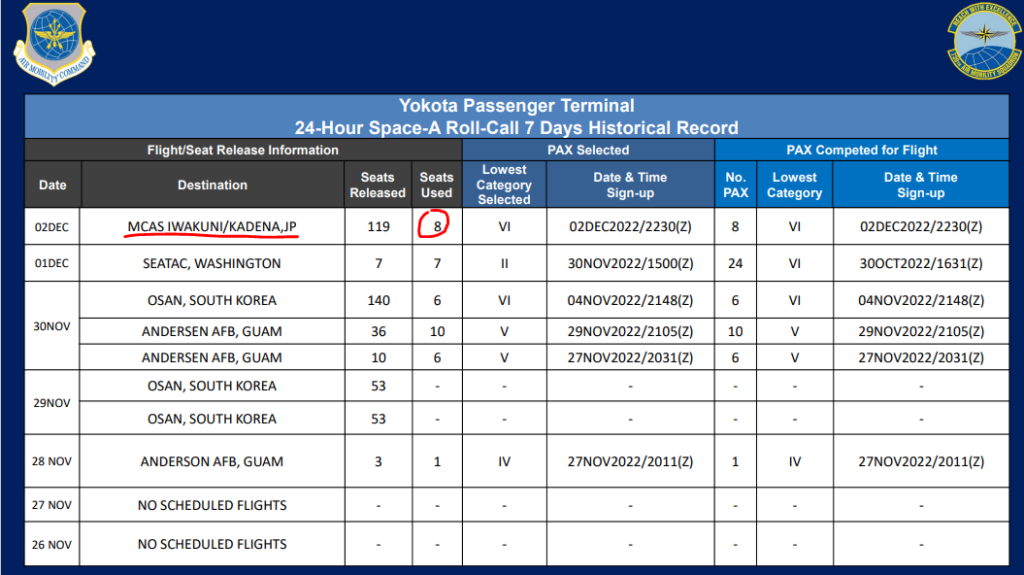
Space-A Passengers are prioritized by your category level, there are 6 levels, and we were a very high category II because we had the signed EML form (Active Duty don’t typically need EML form signed and won’t unless they know they are going to need to compete for seats (Christmas Time/Peak Seasons), but Active Duty can usually only use EML twice a year. DoD Civilians always have to fly EML). After Category level, they widdle down who gets to go on the remaining seats based on the time they signed up for that particular terminal for the Space-A program. You Sign up by emailing the terminal as soon as your approved leave begins (You cannot sign up before your leave begins, unless you are retired military then you can sign up anytime you want, but within 60-days of flight). Luckily we were traveling off-peak season so there were many seats available.
You can find flights by searching for your nearest Passenger terminal at https://www.amc.af.mil/AMC-Travel-Site/AMC-Space-Available-Travel-Page/ . And then looking at their 30-day, and detailed 72-hour schedule. You can see historically if flights have been full by looking at their roll call reports.
We paid $0 for the flights, even the sandwiches they fed us and drinks they provided were complimentary. We were allowed up to two checked bags per person. AF Base Terminals had long term parking for cars available. And all the bases we went to had Hotels/Inns on the base we could stay at, we stayed at the Shogun Inn ($144/night for a 2-bedroom) at Kadena when we arrived and the day before we departed. Also while at Okinawa we stayed at MWR OKUMA Beach Resort (Military Only Resort) with relatively cheap accommodations ($85/night for a 6-person suite) and lots of activities like Jet Skiing ($35 for 2 ppl/20min), Wakeboarding ($35 for 4ppm/20min), Snorkeling ($6/Day Rental Gear), Golf Cart Rental ($45/day), Go-Kart ($6/5min), etc. We ended up renting a minivan through BC Used Car Garage (¥27,900/week) which is a 8-minute taxi ride (¥700) from Gate 2 in Kadena, it was about a third of the price of On-Base Times and other nearby Rental Companies were charging.
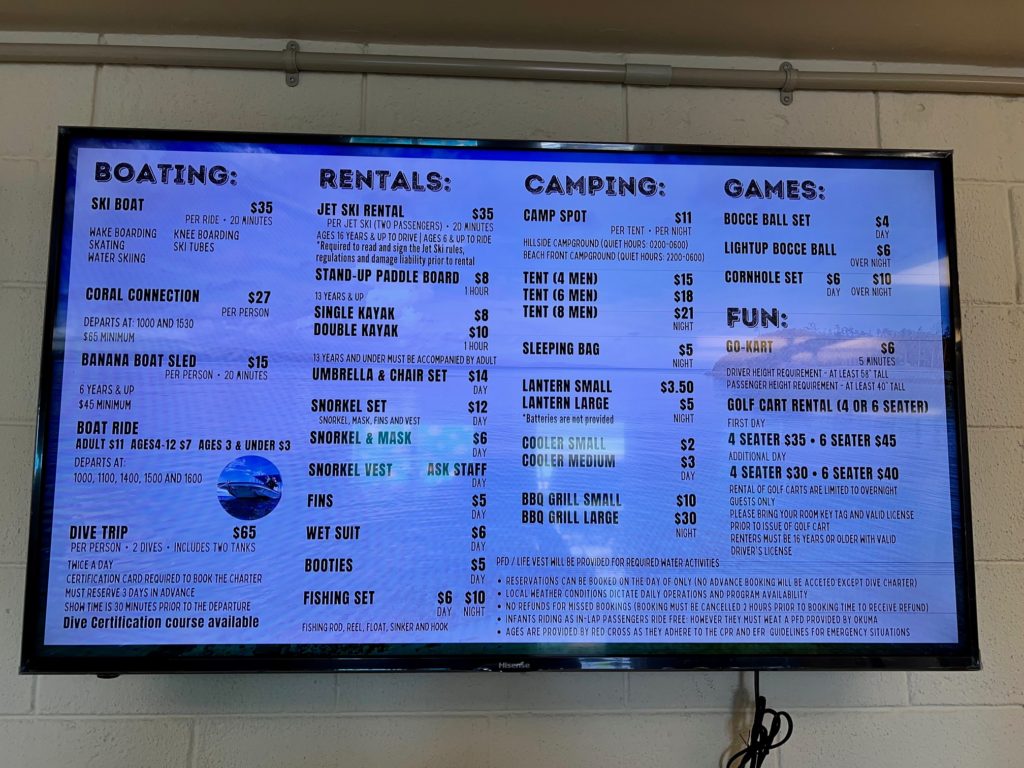
In May 2023, we used SPACE-A to again fly the whole family to Osan Air Base in South Korea for a 5-day vacation in Seoul. This time we decided to fly commercially back home, since we didn’t want to wait for the Space-A to fly back. It would have made it an 8-day Vacation and I was running low of vacation days.
Anyway hope this information can help someone… as a civilian I had never heard of Space-A and it was a little difficult to piece together all the information around the entire process… I did end up making a video of the trip and the Space-A process if anyone is interested:
Conclusion
Well that about wraps it up, if that was helpful, consider writing me a comment letting me know, thanks. Godspeed!

